Yay, you are going to Mauritius! Whether it’s your very first time or you’ve been there before, it must be really exciting! Whenever I hear that someone is heading there, I feel inclined to share all the deliciousness that is Mauritius.
The Mauritian Street Food scene has vastly evolved throughout the decades and every time I visit my home country, there’s something different to try and this is all cool, but what I really yearn for during my visits are the typical Mauritian Street Food.
My heart is just happy when I enjoy these nostalgic bites all over again.
Jump to:
- My most recent trip to Mauritius
- A brief mention of the street vendors veterans of Port Louis
- What is Mauritian Street Food
- How much is street food in Mauritius
- Best place to find Mauritian Street Food
- 27 typical Mauritian Street Food list begins here
- 1. Dholl puri/Dhal puri (Thin pancake filled with dal)
- 2. Roti (Flat bread)
- 3. Halim (Haleem)
- 4. Kebab sandwich (Kabob)
- 5. Briani (Mauritian Biryani)
- 6-10🍜MAURITIAN CHINESE STREET FOOD – BOULETTES
- 11.🥢Hakien (Hakka-style spring rolls)
- 12.🥢Mine frite (Fried egg noodles)
- 13.🥢Mine bouillie (Boiled egg noodles)
- 14-20 GATO DE L’HUILE
- 21-23🥐SAVORY PASTRIES
- 24. Gram bouillie (Black chickpeas with curry leaves)
- 25. Pistache grillé (Dry roasted peanuts)
- 26. Crêpe salé avec satini (Savory crepes with chutneys)
- 27. Merveille avec satini
- Conclusion: Food for thought
My most recent trip to Mauritius
When I went to Mauritius in January 2023, a cyclone was lurking around the corner. Day three of being there, still jet-lagged and the sky was grey and menacing. And yet, I felt blissful because I literally walked down memory lane from Le Caudan to Plaine Verte (about 2kms/1.2miles) just to relive the streets of my elementary school days and try the nostalgic street food I used to eat along the way.
I headed directly to Patisserie Nabeel, and bought a bunch of savory and sweet snacks, sat myself on the bench at the bus stop right there and enjoyed my treats by my lonesome. Nothing mattered but the treats in front of me. After that, I walked back to the city center, soaking wet from the downpour, but along the way relished many many other childhood favorites.

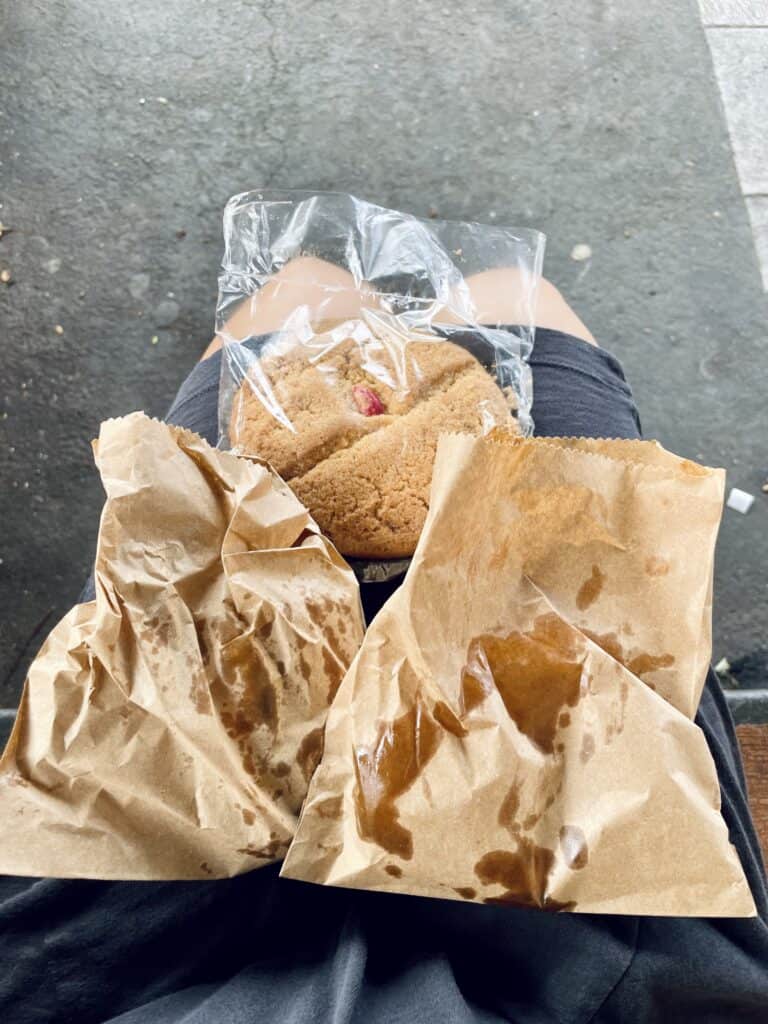
A brief mention of the street vendors veterans of Port Louis
Plaine Verte, the Muslim quarter of the capital, is dear to me. My elementary school, Notre Dame de la Paix, was right next door and I occasionally went to my aunt’s home after school. She lived in the heart of Plaine Verte and I would gulp down rose syrup water or gleefully eat Chinese grass jelly at her place while waiting for someone to pick me up.
Tabagie Vega
Whenever I visit Mauritius, I make sure to visit Tabagie Vega, a small shop barely a block away from my elementary school. I would run there after school because there is no such thing as a line in Mauritius. So you’d have to be fast to be amongst the first to be served (that’s a little tip for your visit to Mauritius and I’m only partly joking)!
The owner, Mr. Vega, opened the shop about 60 years ago. I have fond memories of him as he seemed amused by us impetuous children, incredibly patient and never stern.
To this day, he is always kind and always smiling. He says he still remembers me from back in the day and I’d like to think that’s true because he was an important part of my childhood.
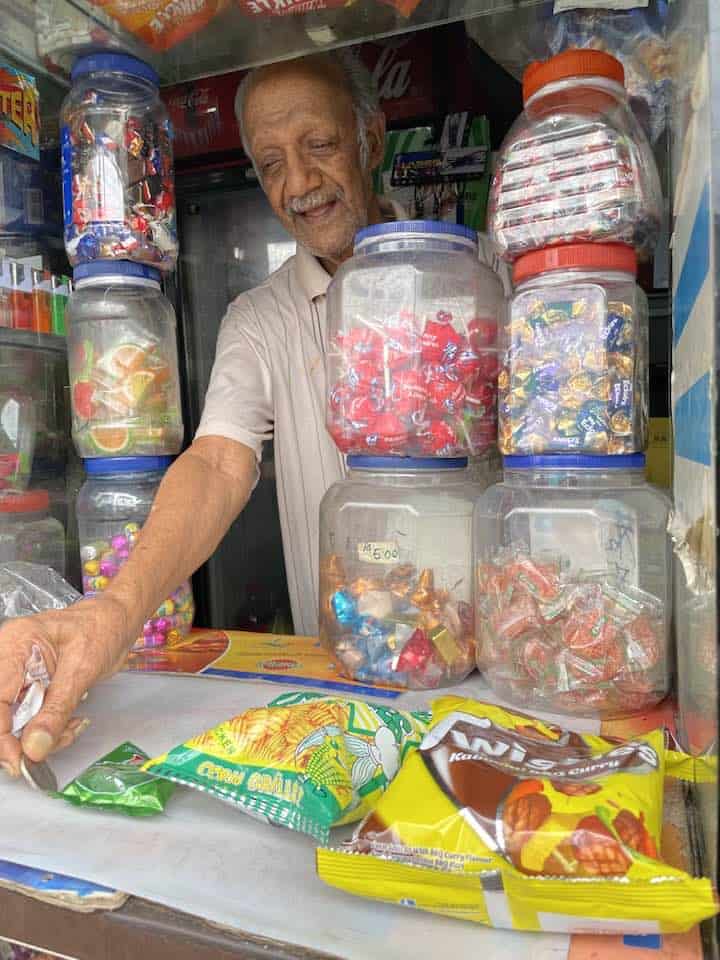
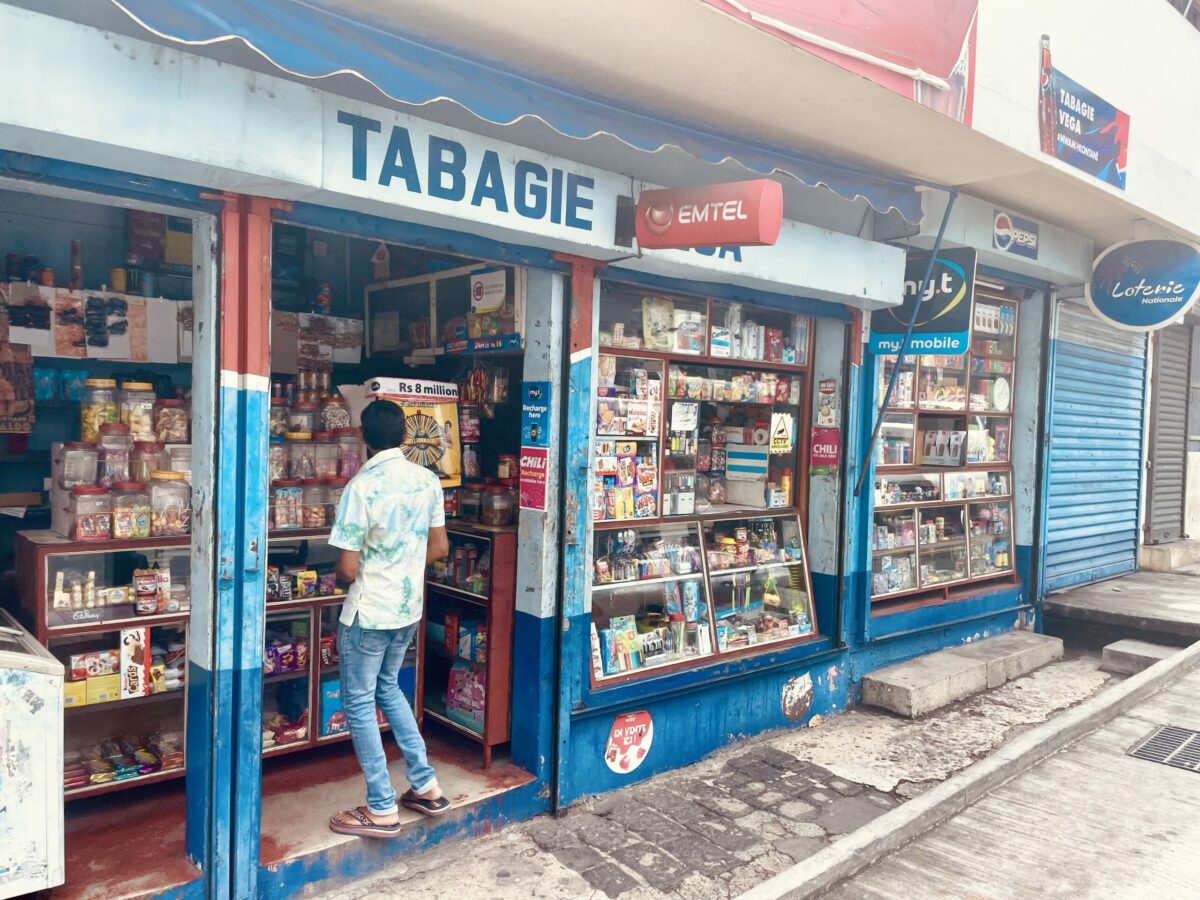
Monsieur Ajam – Corn pudding vendor
A man with a quiet disposition, Mr. Ajam has been selling corn pudding for decades. In my high school years in the 90s, he was right across the street from the post office in the Emmanuel Anquetil building in Port Louis.
Back then, he was also selling roasted vermicelli puddings. He has now moved to a different location (closer to his home) by Richard House.
The last time I spoke with Mr. Ajam, he mentioned that his wife was not doing too well and he continues to work because of that. Maybe try one of delicious corn pudding if you see him in Port Louis?
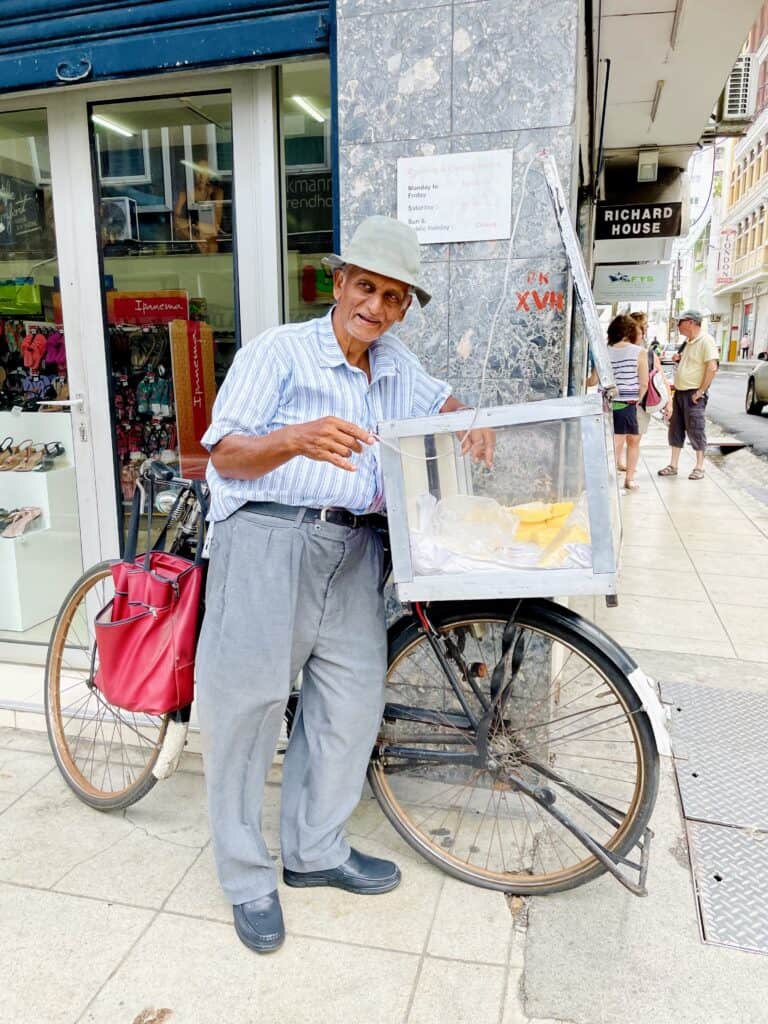
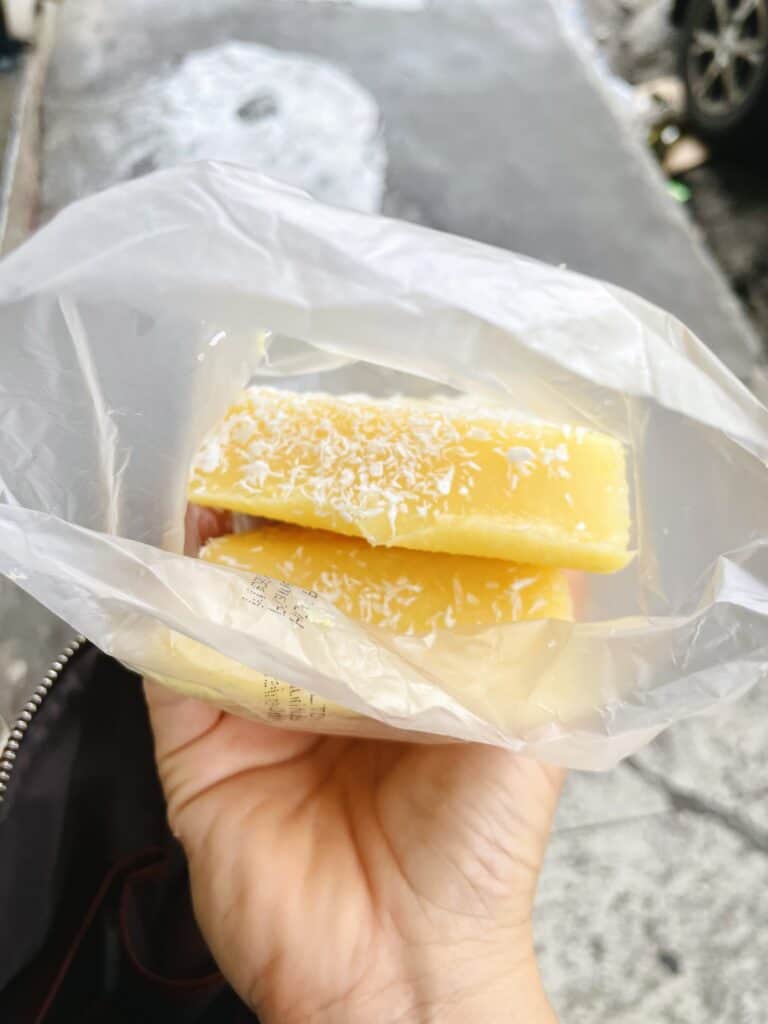
Monsieur Magdad – Shaved ice vendor
Mr. Magdad is another street vendor veteran in Port Louis. He sells shaved ice using an old-school machine and tops it with condensed milk and several types of syrups including my favorites: almond syrup and tamarind syrup.
He always greets you with a warm smile as if he has always known you and in my case, he has known me since childhood even though he probably doesn’t know it. You can find him at Remy Ollier Street in Port Louis. Ask anyone where he is, everyone knows him!
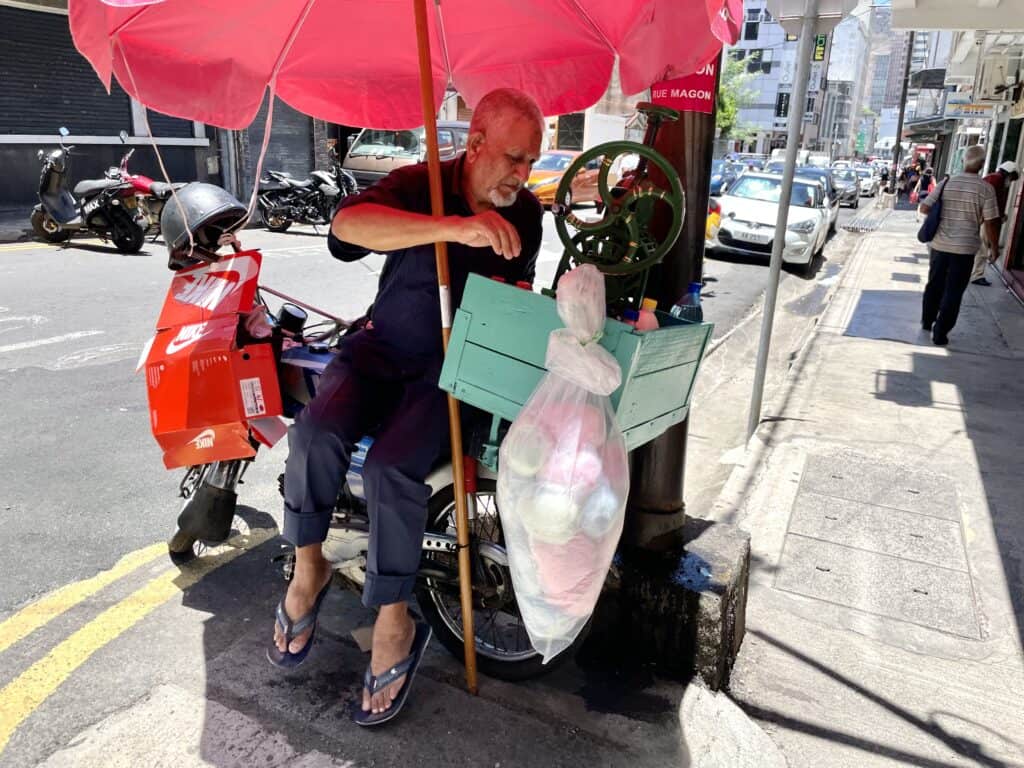
What is Mauritian Street Food
Mauritius is known for its deliciously diverse cuisine, which is an amalgamation of Indian, Chinese, African and French influence and our Mauritian Street Food embodies just that. To truly experience Mauritius, you should not miss the 27 typical street food enjoyed by locals.
Street food vendors are peppered all over the island with a huge concentration in the capital of Port Louis, buzzing towns like Rose-Hill and Centre de Flacq, around the popular beaches like Grand Baie, and most bazaars (markets).
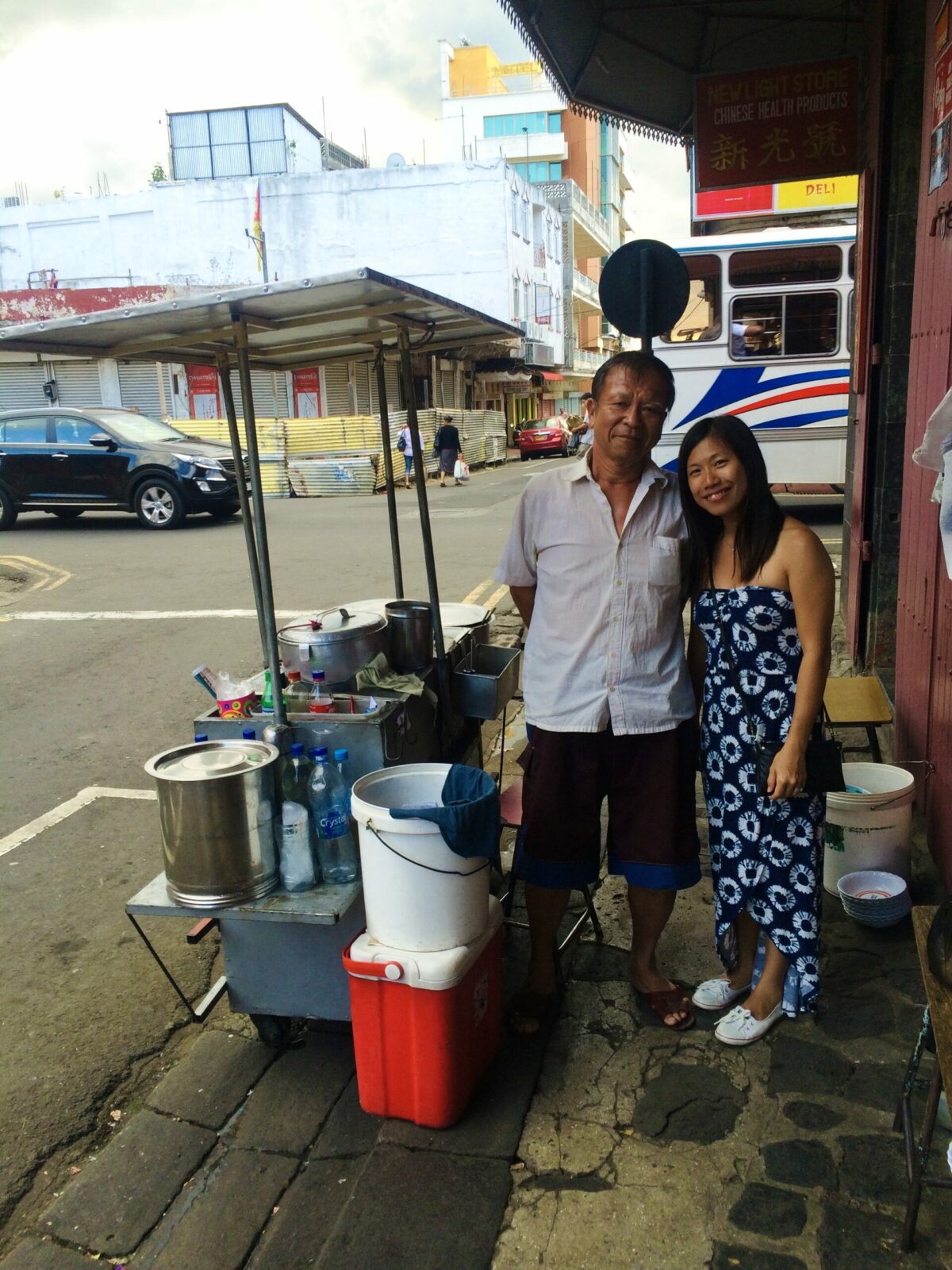
Photo: Mr. Arthur, aka Gros Piti, Noodles and Boulettes Street Vendor in Chinatown.
How much is street food in Mauritius
This is in no way an exhaustive list of our street food fares, but consider yourself accomplished if you’ve managed to sample all of these essential Mauritian street food. I did my best to make this page easy to navigate.
I choose to not include the prices because in the grand scheme of things, street food prices are pretty negligible. The snack sizes street food will only set you back by Rs.44/£0.80/US$1.00, if even, and a whole street food meal would only cost Rs.110/£2/US$2.50 on average.
Of course restaurant prices are higher.
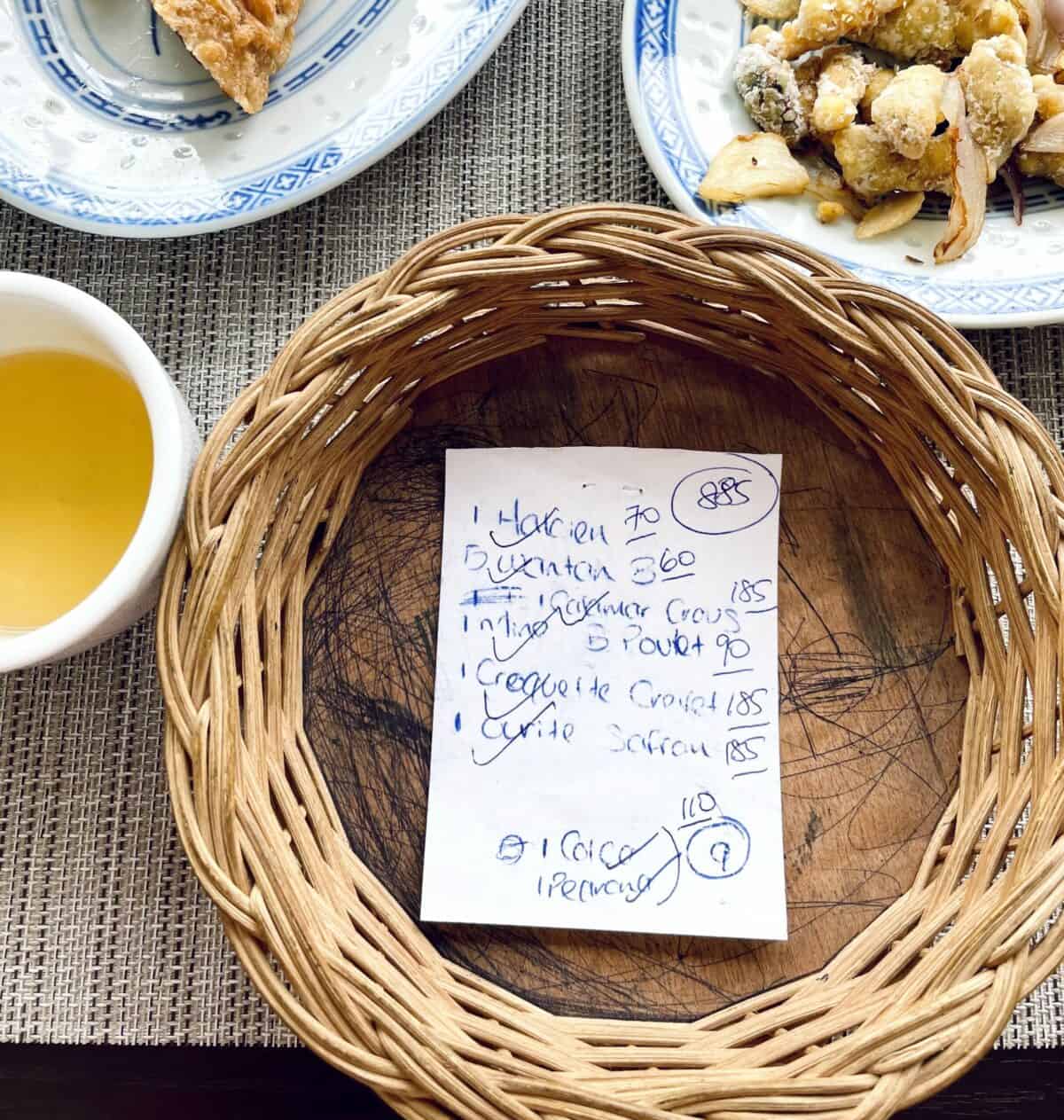
Best place to find Mauritian Street Food
As I deemed helpful, I also included places or where to eat in Mauritius, but for the most part this list focuses on what to eat when visiting our island.
Please bear in mind that most street food vendors or hole-in-the-wall eateries, or even restaurants don’t have a proper website in Mauritius, but they can sometimes have a Facebook Business page.
When available, I’ll put a link to their website or Business Facebook page. We have a lot of ground to cover, let’s get started, shall we?
27 typical Mauritian Street Food list begins here
1. Dholl puri/Dhal puri (Thin pancake filled with dal)
Dholl puri (pronounced doll-pooree) is the unofficial national dish of Mauritius. It’s easy to see why: Soft, delicate and bursting with flavors from the perfect mix of savory, spicy and tangy fillings, they are what Mauritian expats dreams are made of.
This is the dish that we miss the most from the Motherland.
Originally Indian, more reminiscent of an Indian flatbread than a deep-fried puri, the Mauritian dholl puri is a thin pillowy flour pancake stuffed with parboiled ground yellow split peas and turmeric.
It is gently cooked on a tawa (flat iron griddle) without leaving any brown marks on the pancake.
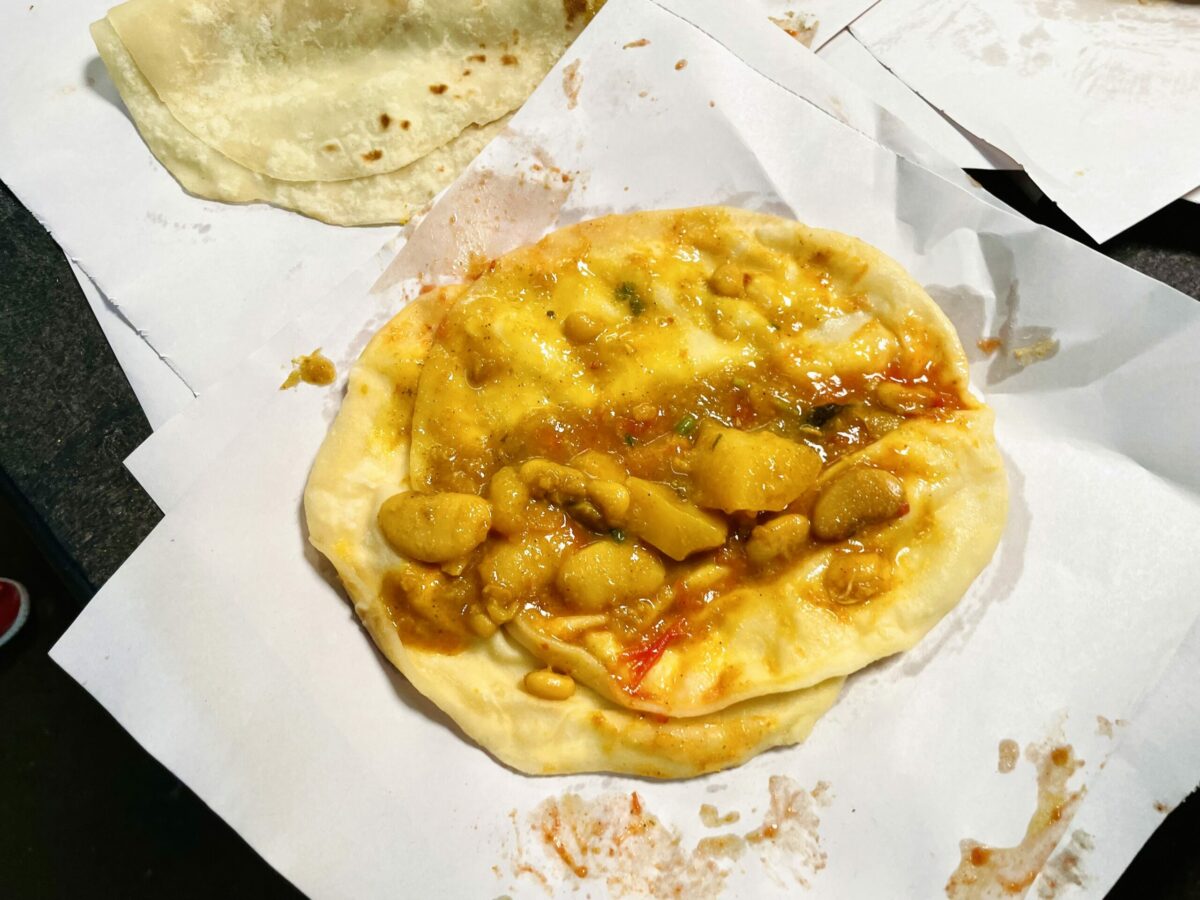
Dholl puris are served hot, and in pairs, with a variety of vegetarian fillings. Dholl puris are always vegetarian, and can be considered vegan too since there are no dairy ingredients.
The most common fillings for dholl puris are:
- Lima bean curry (cari gros pois)
- Rougaille (a tomato sauce mixed with onion and garlic)
- Vegetable achard
- Green chili achard
- Mazavaroo chili paste
- Fresh whole green chili peppers
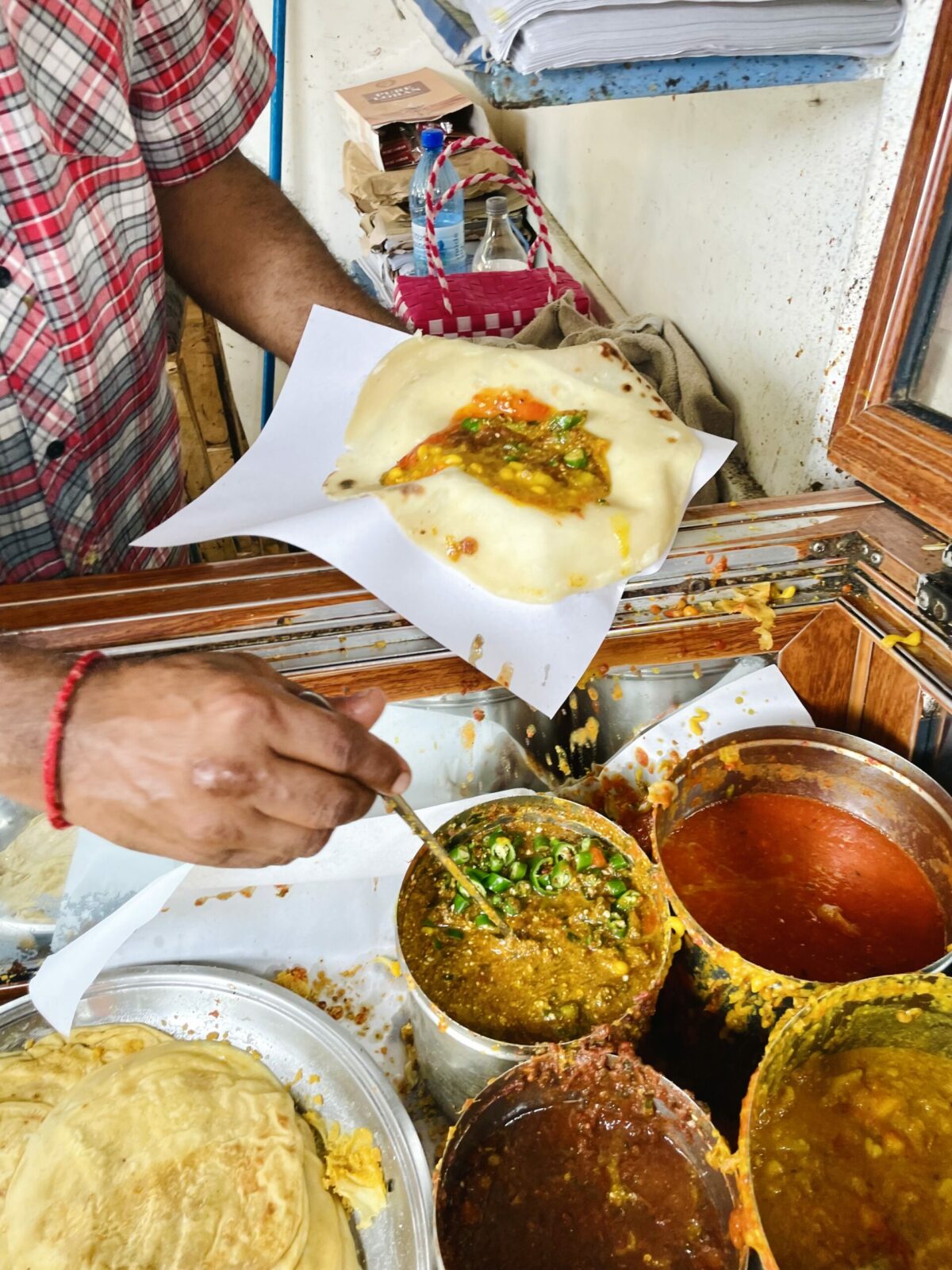
Where can I find the best dholl puri?
The name Dewa has become synonymous with dholl puri. In fact, they are so popular that they have several locations across the country and some Mauritians wouldn’t have dholl puri from anywhere else.
But then along came Chez Bye and some Dewa advocates changed their minds and switched side. I’ve had both and I, for one, refuse to enter the debate because they are both equally drool-worthy and perfectly capable of haunting your dreams.
As of 2023, Chez Bye has only one location, in Rose-Hill in Old Arab Town at 117, Prince of Wales St, Rose Hill.
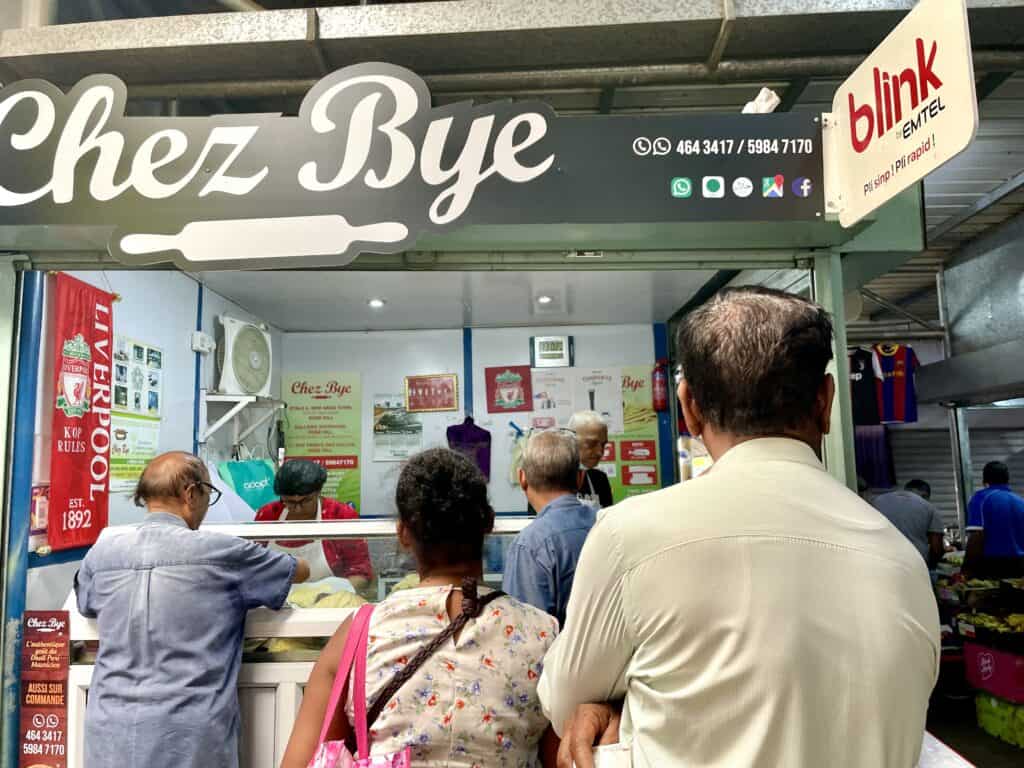
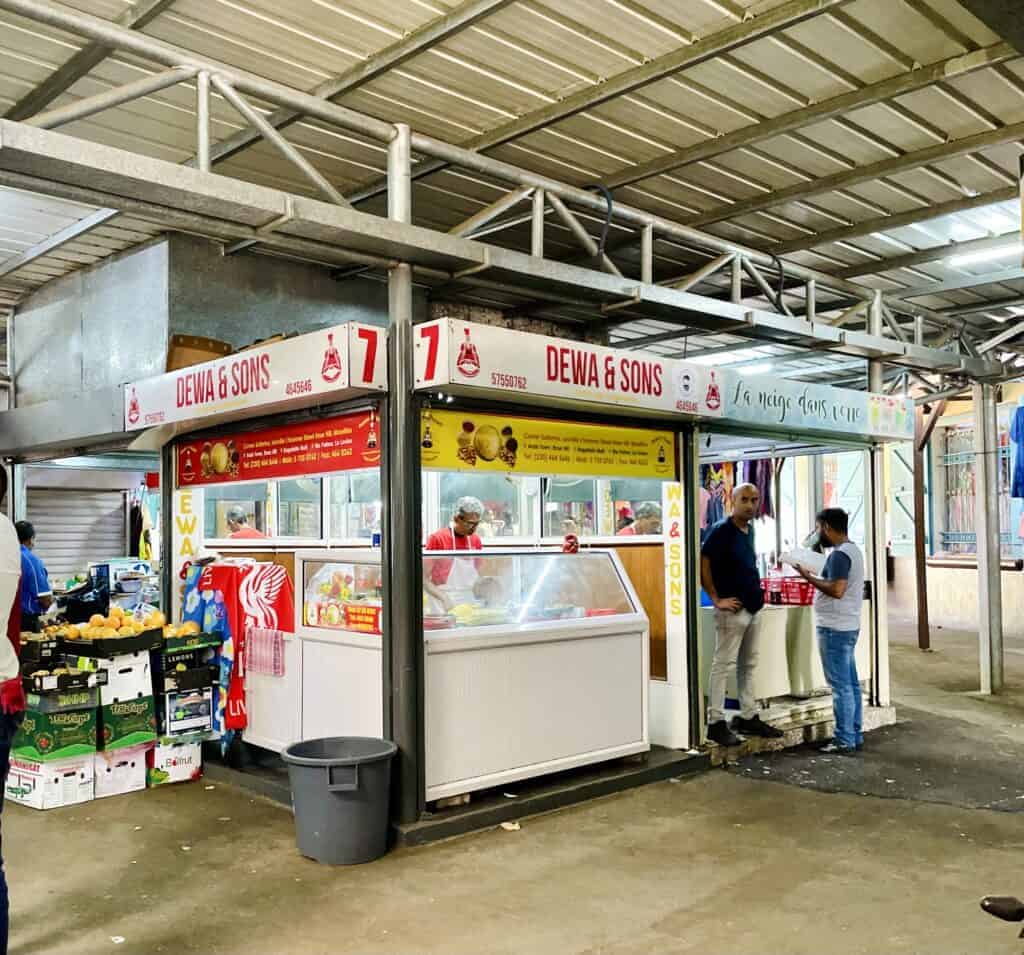
2. Roti (Flat bread)
The Mauritian roti is derived from the Indian roti but differs in that it uses plain white flour instead of wheat flour. Our roti is a mixture of plain white flour, water, oil and salt, kneaded together to make a soft dough.
After a short rest period, the roti is rolled flat and cooked on a tawa. Unlike the dholl puri, the roti has tawa marks on it.
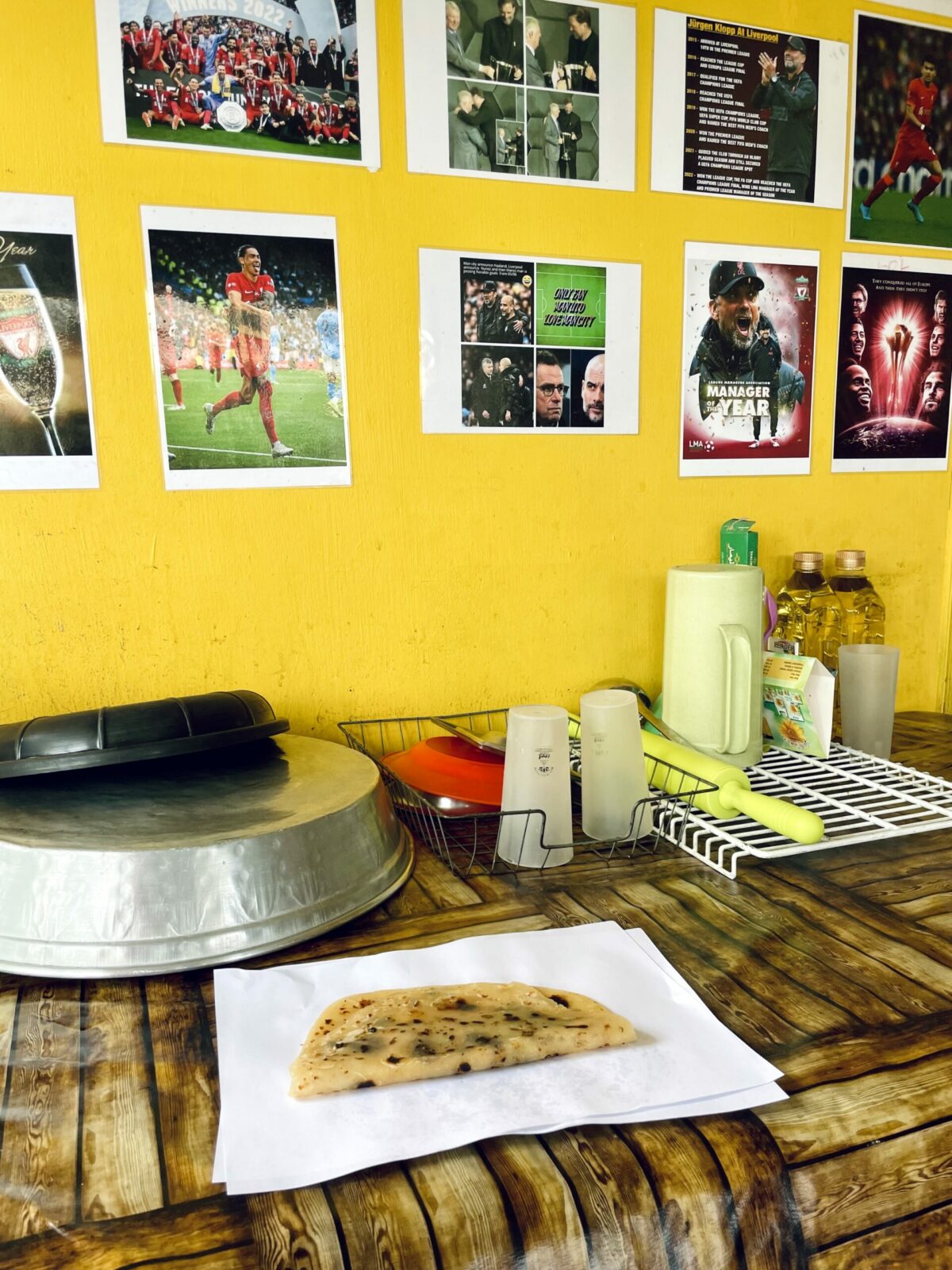
Roti sold by street vendors are vegetarian and are served with the same fillings as that of a dholl puri. However, they can sometimes also include brède songe (a filling made with taro leaves) along with other types of vegetable curries.
Roti are in close competition with dholl puri and I say: “Why pick? Get them both!”
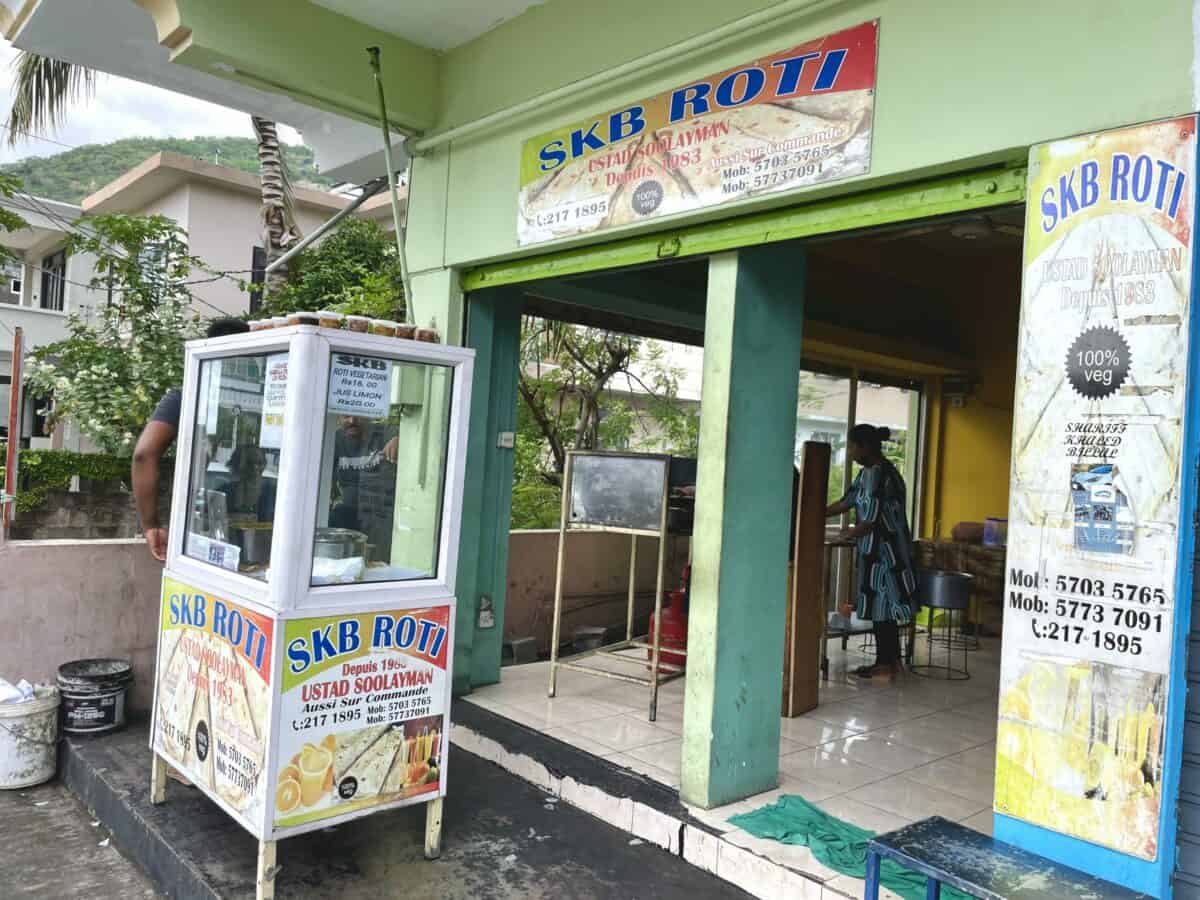
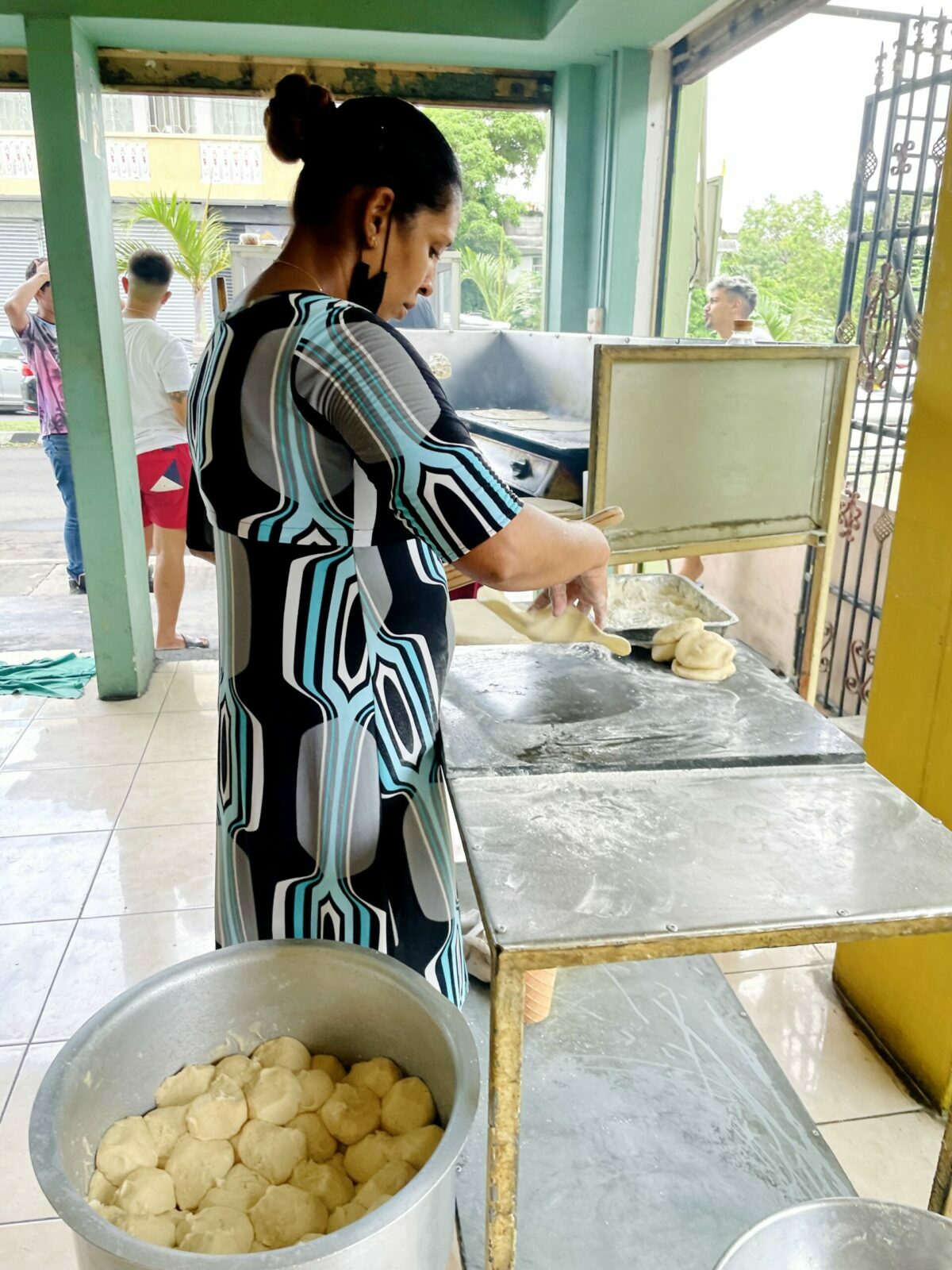
3. Halim (Haleem)
The Mauritian halim (pronounced ah-leem) is thinner and lighter than its Middle Eastern and Indian predecessors. Warming and hearty, halim is a lentil and cracked wheat soup with little morsels of melt-in-your-mouth fatty lamb or mutton.
It is served piping hot, topped with loads of chopped green onion and a side of brown vinegar (similar to malt vinegar), red hot sauce and a piece of bread. Be careful to not burn yourself upon sipping, and don’t ask me how I know!
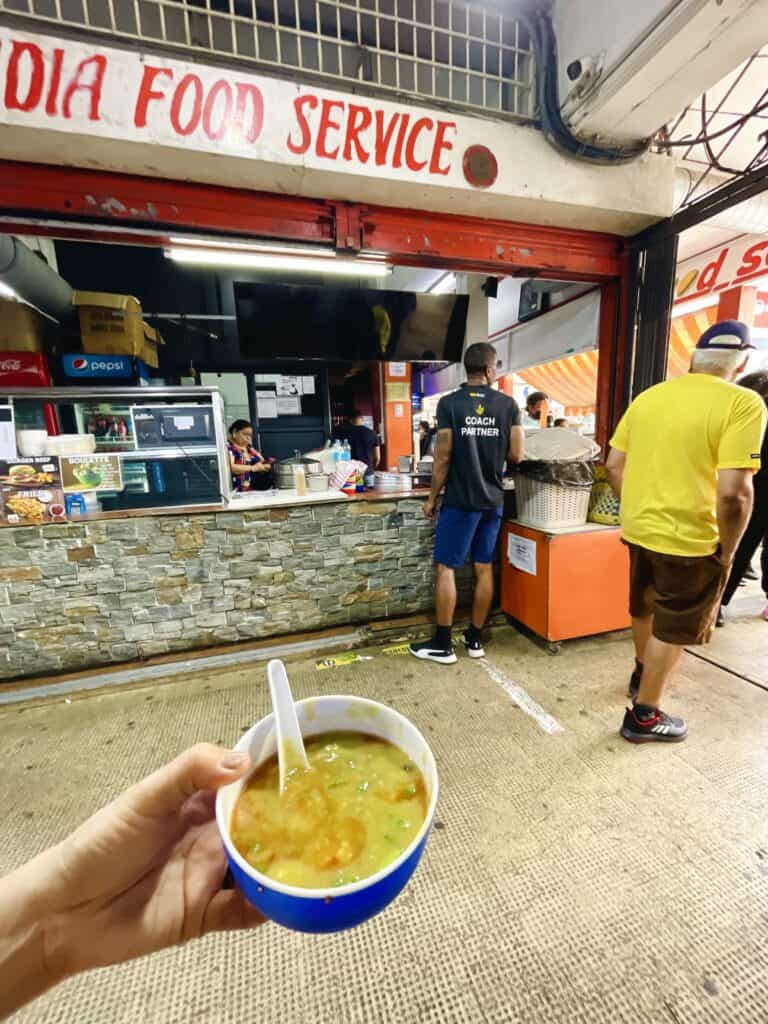
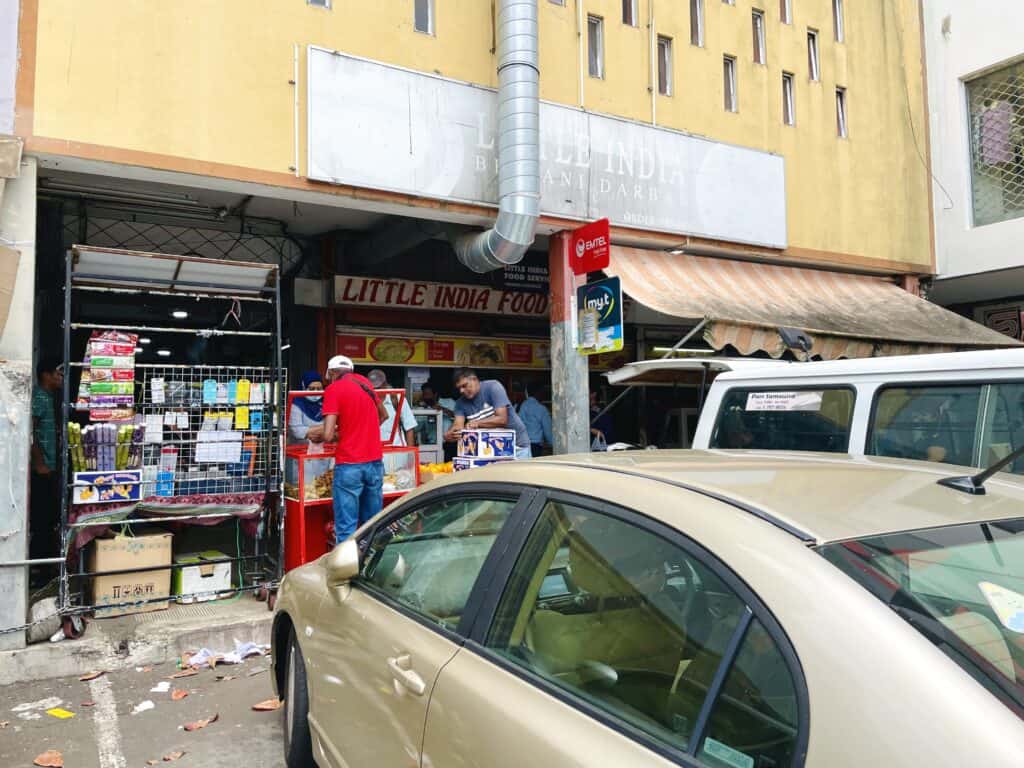
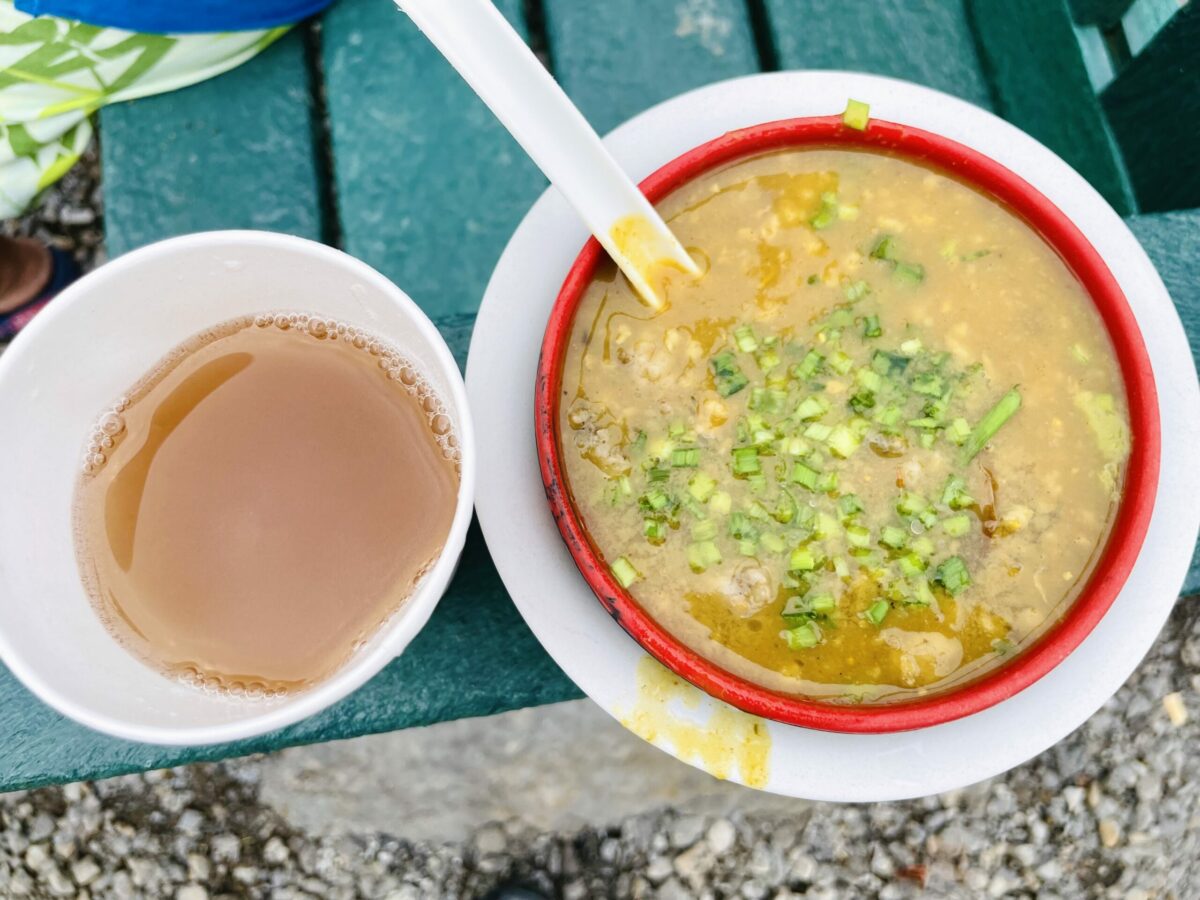
Halim is worth the hunt or you can head directly to a shop called Little India Food Service near the Metro Station in Rose Hill. There is also a brand new halim vendor in the Mahebourg Market.
Unfortunately I did not write down their names. From what I recall they haven’t picked one yet when I visited but their halim was truly phenomenal.
Please write me a comment if you know their shop’s name! See their picture below.
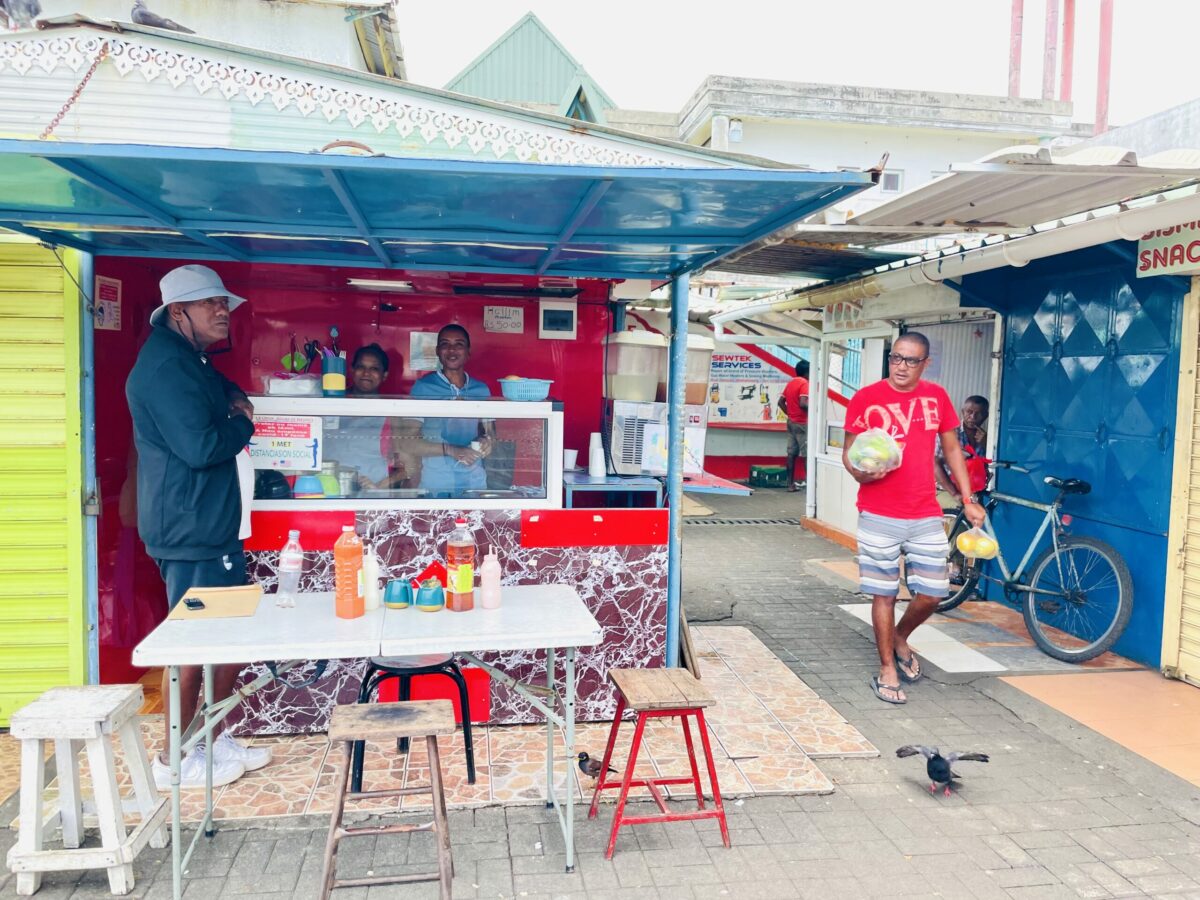
4. Kebab sandwich (Kabob)
Kebab (pronounced kay-baahb) is delicious. Full stop. I’m not quite sure why our kebab sandwich doesn’t make it on other must-try Mauritian street food lists, as it is absolutely one of the best sandwiches you will try in your lifetime.
Our Mauritian Halal chicken kebab is light, not heavily spiced, and what makes it distinctly Mauritian is the generous spread of our homemade Mauritian mayonnaise and green chili paste in a fresh crispy baguette. These are literally the secret sauce(s) to my obsession with that spectacular sandwich.
Kebab and I go far back. When I was in high school, a kebab truck would show up right at lunchtime. About a half hour before then, you can bet all I could think about was that delicious kebab sandwich, and not the many ways Hamlet is a tragic hero.
Do not miss it on your next trip to Mauritius!
5. Briani (Mauritian Biryani)
Our Mauritian briani (pronounced bree-ah-knee) seems unassuming at first. We sell it on the streets and in hole-in-the-wall places, you think, “Yeah, sure I’ll try yet another biryani,” and then bam it’s love at first bite!
It hits you with flavor: First you notice the tangy spiciness of the green chili paste, then the freshness from the cucumber salad and chatini pomme d’amour (fresh Mauritian tomato chutney) and finally the subtle Mauritian briani aroma that brings the whole experience home.
You could travel in most parts of Indian and the Middle East without finding a briani exactly like ours. The flavor is cleaner in that it is not heavily spiced, and the marinade is mixed with a generous amount of mint and cilantro that gives our briani a fresher taste and a lighter feel.
We use chicken, beef or lamb, oftentimes halal, in our briani but you can also find vegetarian versions as well. We also love to add a generous amount of fried yellow potatoes and eggs. It’s always accompanied by a few condiments, most often a cucumber salad, fresh tomato chutney and Mazavaroo Chili Paste.
Star Deg is the most popular establishment for briani.
If you’d like to make it yourself, check out our foolproof Mauritian Chicken Biryani recipe!
6-10🍜MAURITIAN CHINESE STREET FOOD – BOULETTES
Simply put, there is no Mauritian street food without Chinese boulettes (pronounced boo-let). Boulettes means balls in French, but in Mauritius it can also mean Chinese dumplings usually ball-shaped ones, but not always.
Mauritian boulettes are enjoyed with or without broth and are served hot with loads of chopped green onion and some mazavaroo. The broth is called bouillon and is usually only composed of water, monosodium glutamate and green onion.
The boulettes are usually kept in one large steamer with several different types to choose from. So you’ll have the opportunity to mix and match a variety of them in a bowl and you can even try one with broth and one without.
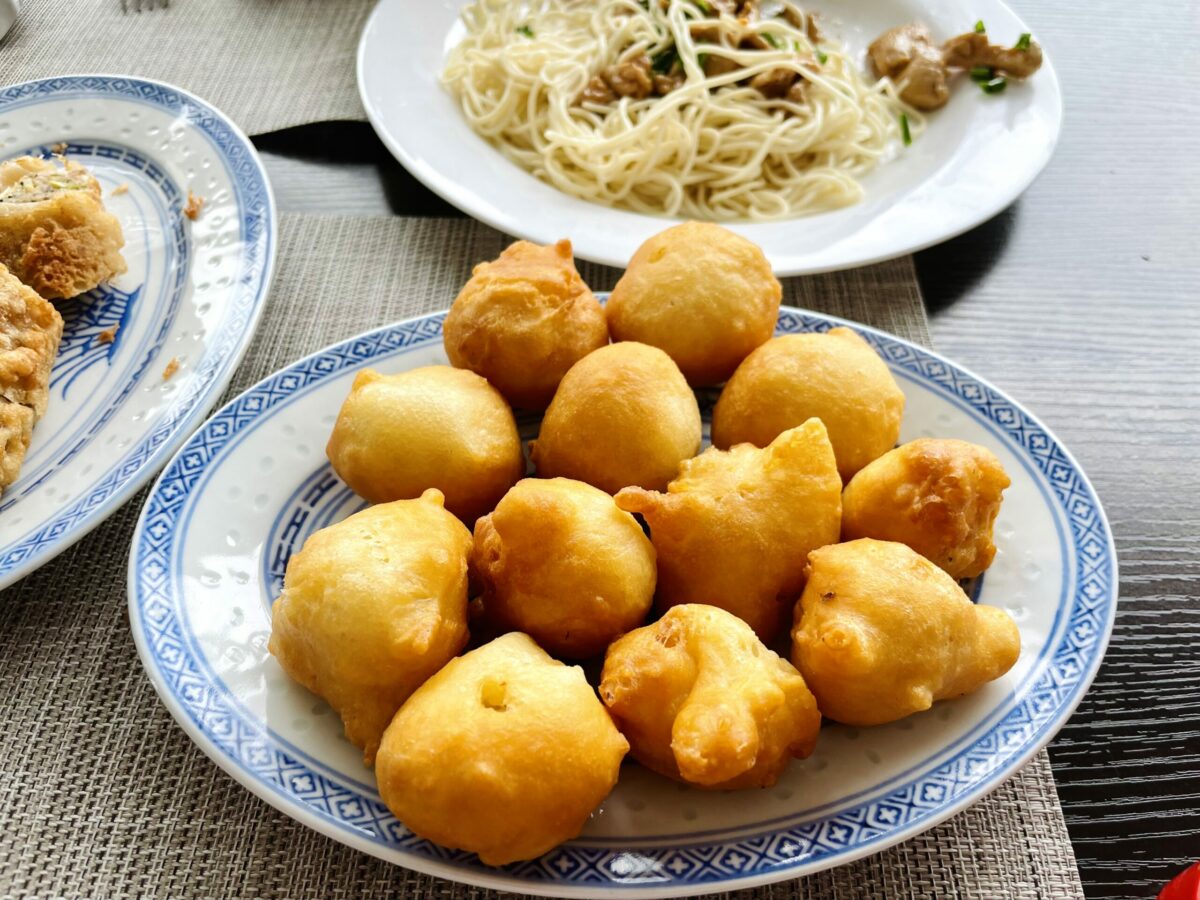
6.🍜Niouk yen (Chayote balls)
Niouk yen (pronounced knee-ook yen), also called boulette chouchou, is by far the most popular type of boulettes in Mauritius. Niouk yens are steamed Chinese Chayote Squash Dumplings, that can be prepared with or without meat. Chayote squashes are called chouchou in Créole hence the name: boulette chouchou.
To find out how to call chouchou in other languages, check out our Mauritian Ingredient Translations. Or try your hand at my own Boulette Chouchou Recipe inspired by my Grandma’s.
7.🍜Boulette poisson (Fish balls)
Our boulette poisson tend to be less sweet than its Chinese counterparts and this really sets them apart. I love to eat them with bouillon (broth) and some chili paste.
8.🍜Boulette – la viande (Beef meatballs)
Boulette la viande are usually mixed with a tinge of ginger. While I do like them a lot, I much prefer the other types of boulettes.
9.🍜Wantan (Wonton)
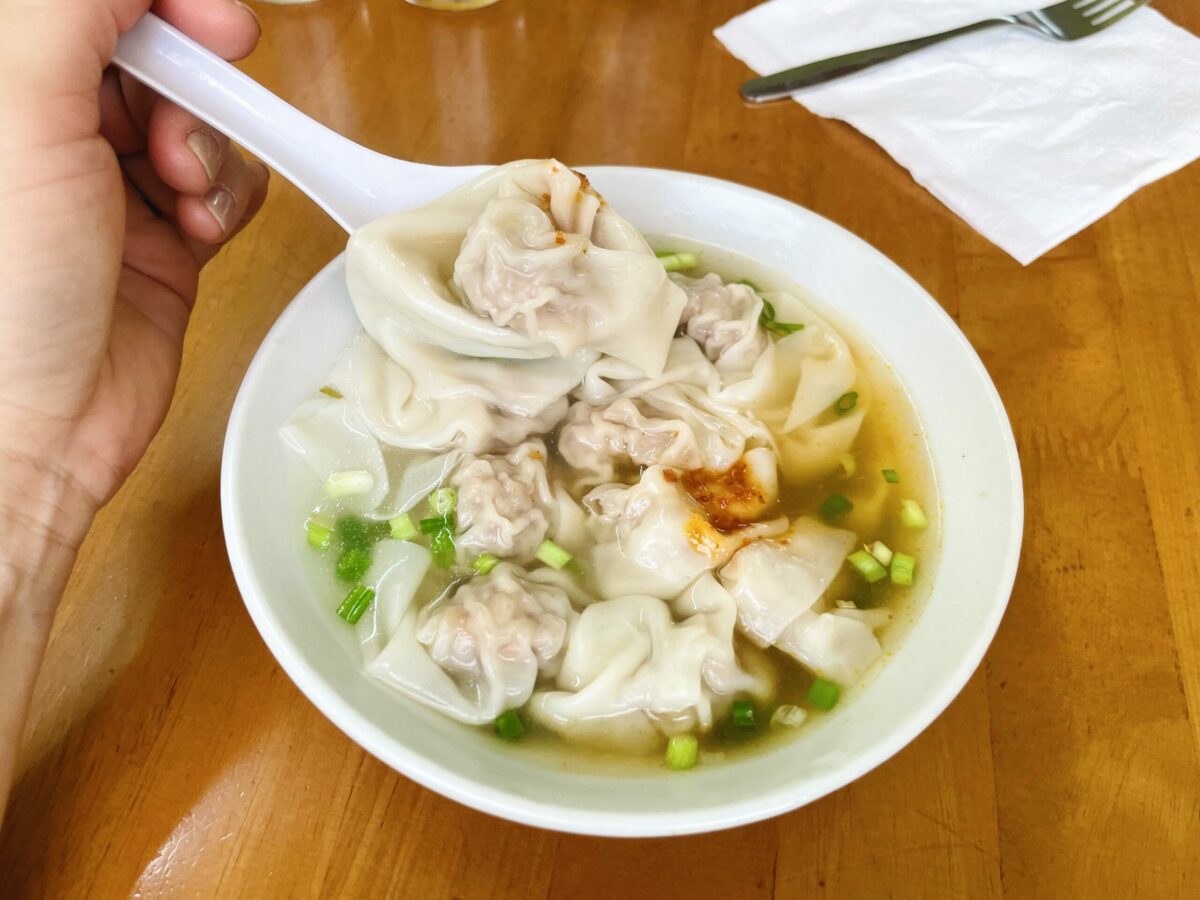
There are two types of wantans (pronounced wan-tan): deep-fried or gently simmered in broth. The delicate and thin wantan sheets are filled with small balls of minced chicken and dried squid powder.
While the deep-fried Mauritian wontons are very tasty, I somehow always go for wantan with bouillon. I never fail to get a big bowl on each visit to Mauritius. Since wantan are normally sold with other boulettes, I’m adding it to that category of food.
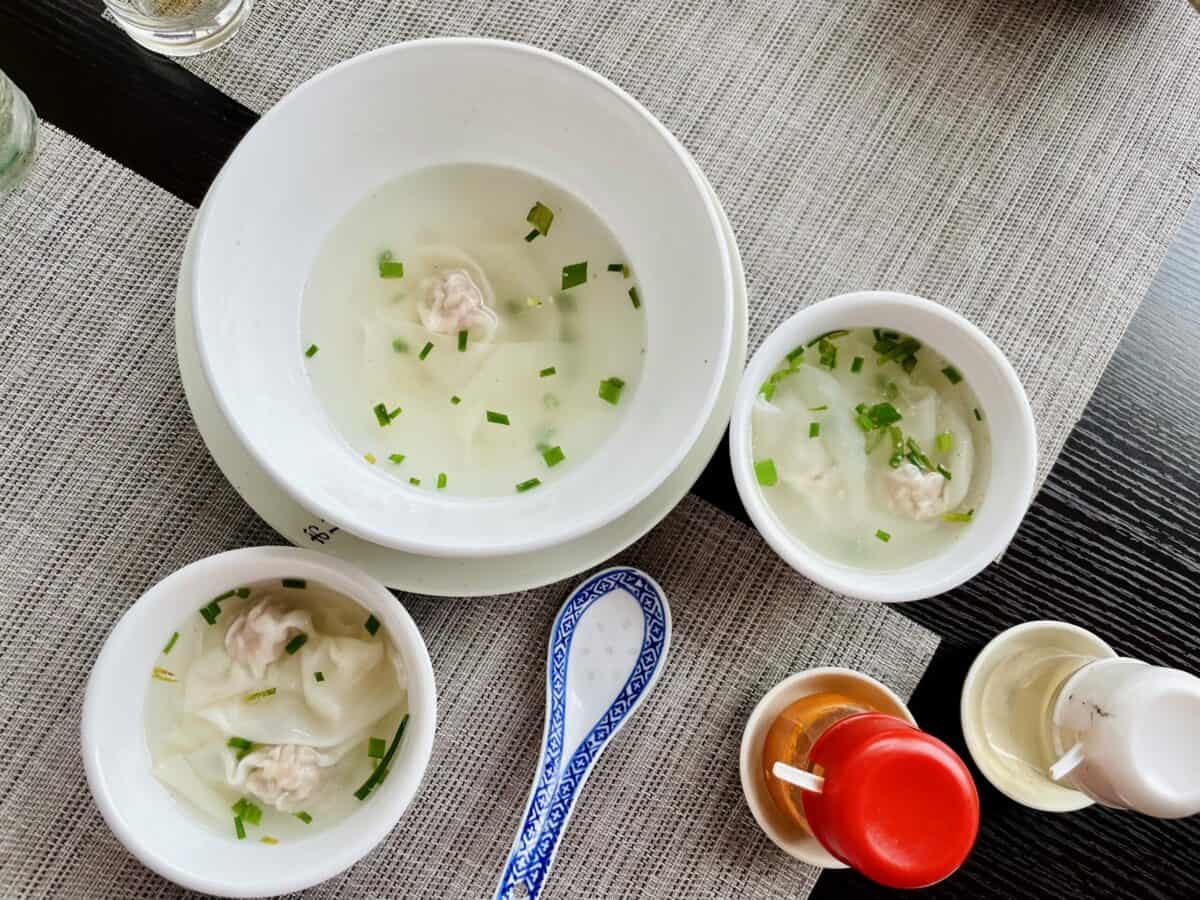
10.🍜Teokon (Stuffed tofu)
Teokon (pronounced tay-oh konn) by themselves mean tofu but when sold along with boulettes, they are usually stuffed with some type of minced meat though the name remains the same.
Teokon are fried then steamed so that the middle of the teokon is cooked through. It’s very delicious and I highly recommend you get one with the rest of your boulettes.
11.🥢Hakien (Hakka-style spring rolls)
Hakien (pronounced hah-kee-end) is a little hard to find but I’m including it here so that you keep an eye out for it. Super crispy and light, hakien are a traditional Mauritian-Hakka food very similar to Chinese spring rolls but roughly twice the size.
Homemade spring roll sheets are filled with a mix of meat, like pork or chicken, and shredded vegetables like carrots, cabbage along with wood ear mushrooms (or black fungus). It is usually served piping hot with some garlic water and chili sauce.
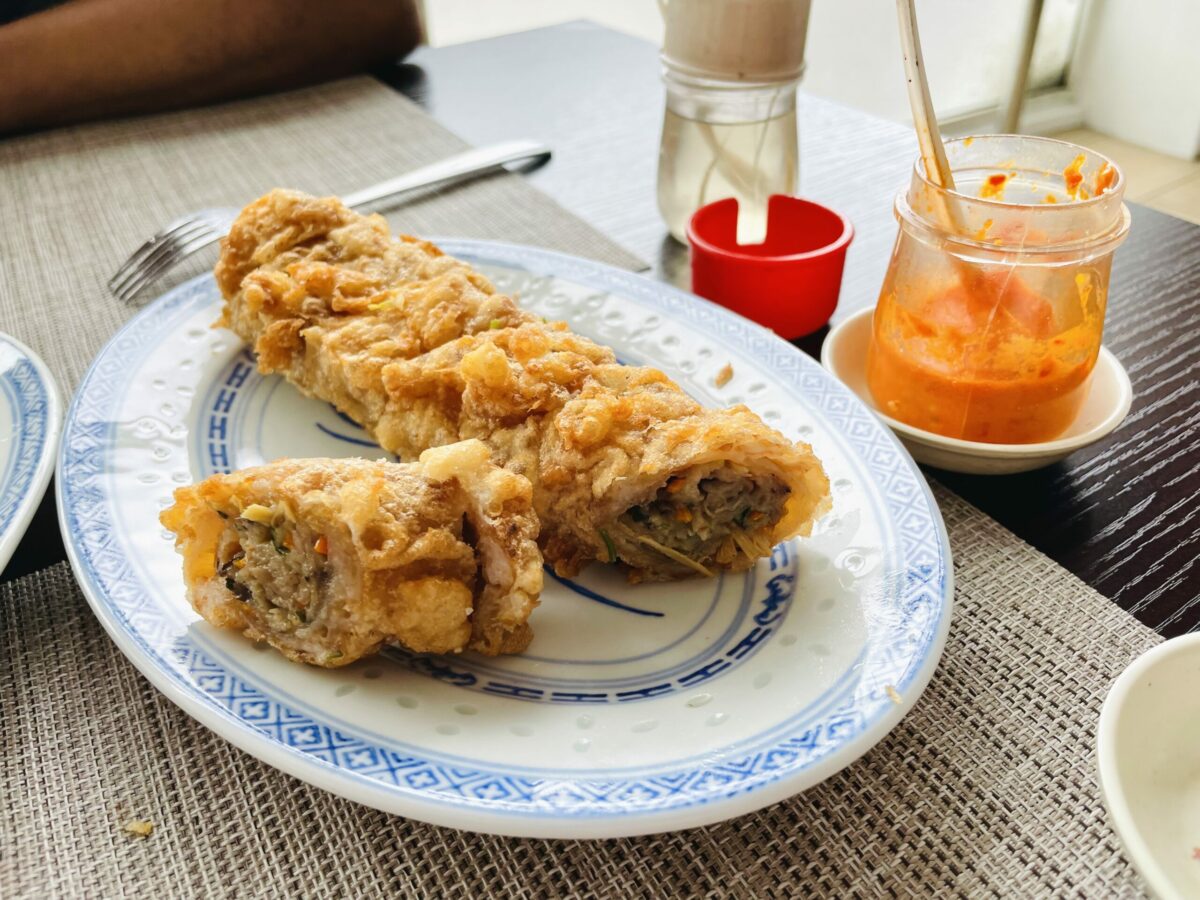
12.🥢Mine frite (Fried egg noodles)
Mine frite (pronounced meen freet) are egg noodles that are fried in flaming hot wok. The proteins of choice are chicken, beef, pork but you can also find vegetarian version with shredded Chinese omelette.
They are a local favorite and you’ll find them all over the island both as street foods and in Chinese restaurants and everywhere in between.
What makes our mine frite different from the more common Chinese fried noodles is our ingredients. In Mauritius, we prefer to use garlic chive to the green onion and we also add a handful of mung bean sprouts. Mine frite are seasoned simply, with just some soy sauce, white pepper and a little bit of fish sauce.
These may seem like minor tweaks but if you make regular Chinese fried egg noodles without the garlic chive and mung bean sprouts, and dump a bunch of seasonings in, they likely won’t quite taste Mauritian.
Mauritian fried noodles are enjoyed with a generous amount of garlic water and Chinese Red Chili Paste.
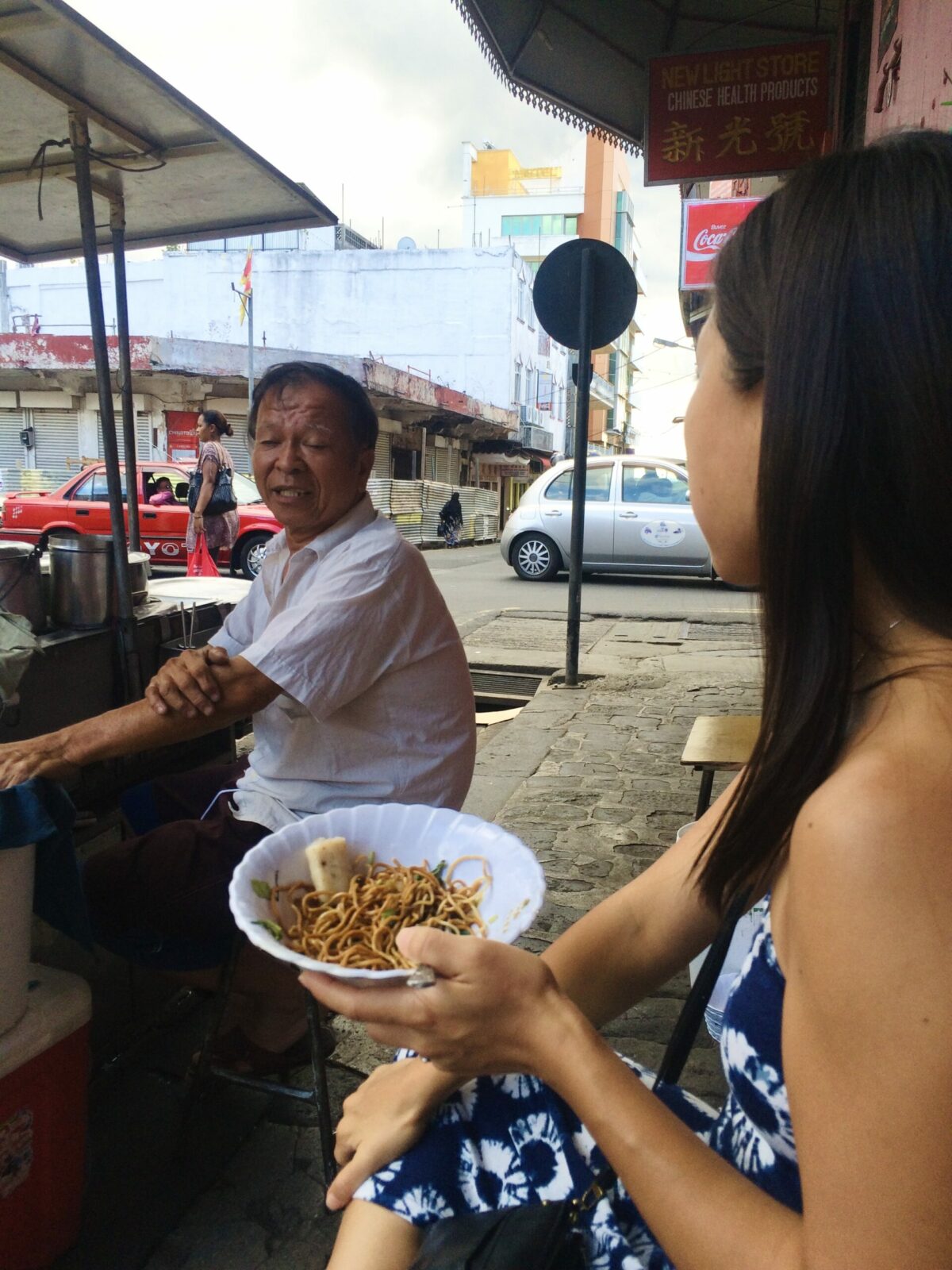
13.🥢Mine bouillie (Boiled egg noodles)
A good mine frite can rock my world, but mine bouillie (pronounced meen booee) somehow holds a special place in my heart. I just love its simplicity. This dish might not blow your mind but it surely is comfort food for Mauritians.
A basic Mauritian mine bouillie consists of flash boiled egg noodles, topped with sautéed or braised protein like chicken, beef or pork, and a generous amount of chopped green onion. The whole lot is served with some garlic water and chili sauce.
Octopus mine bouillie can be found in some coastal parts of the island like Chez Coin Casse Croûte in the small southeastern town of Mahebourg.
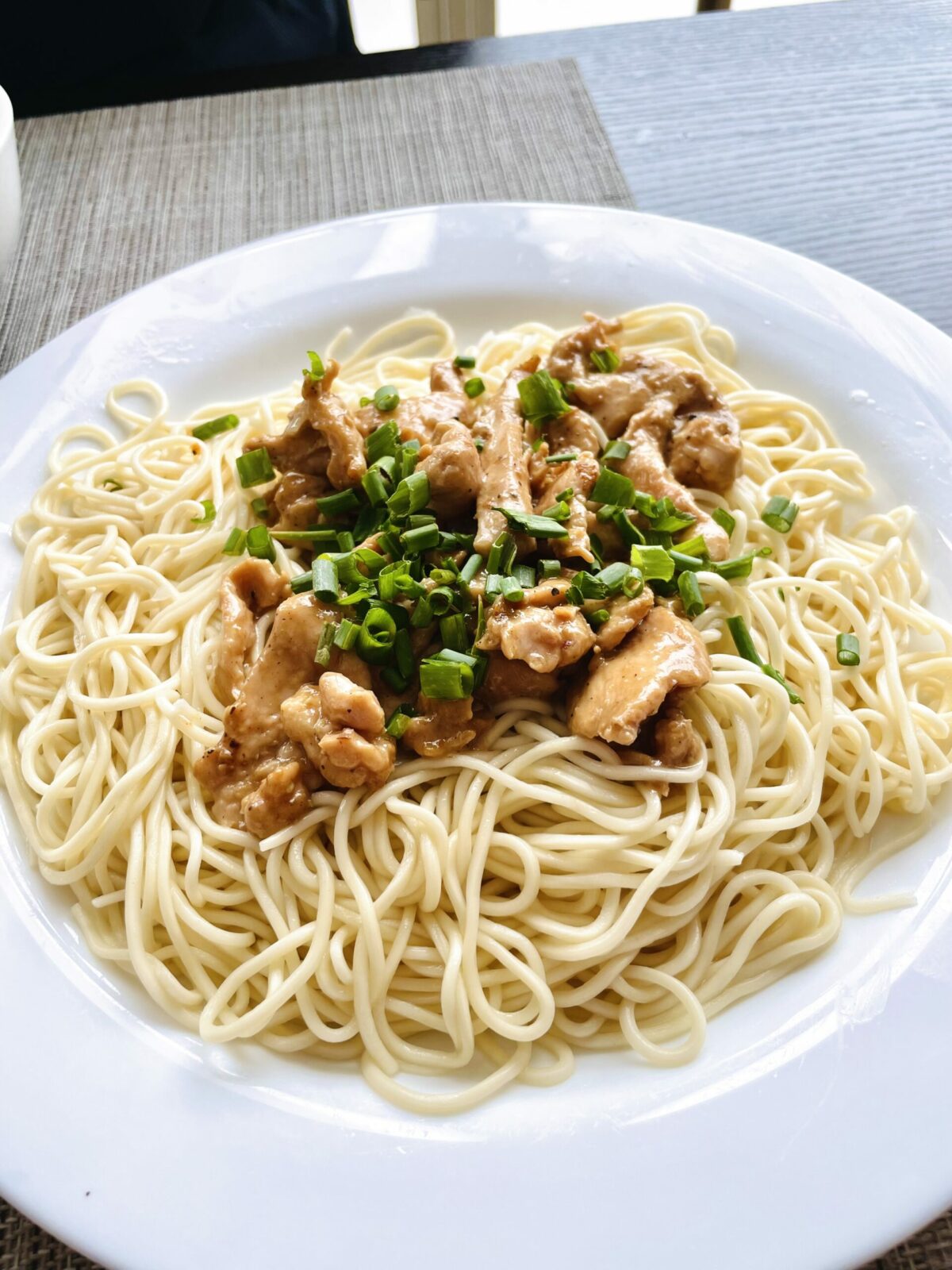
14-20 GATO DE L’HUILE
Gato de l’huile is Créole for “oily cakes” and gato is an umbrella term for many different types of Mauritian food including an actual cake. It can be confusing for the uninitiated so for now, think of gato de l’huile as savory fritters.
As you can imagine, these tasty bites are not very healthy. So with today’s increasing focus on health food, and the modern palates growing more “sophisticated”, people have scaled back on treating themselves to these nostalgic street fares and gravitate towards other snacks.
There used to be a lot more street vendors selling gato de l’huile back in the day, and were served at all hours too.
The marchand (street vendor) heats a large cast iron wok with gallons upon gallons of oil (huile) and the gato is deep-fried throughout the day and served burning hot, hence the term “gato de l’huile.” Nevertheless, they are not to be missed and are absolutely worth biting into!
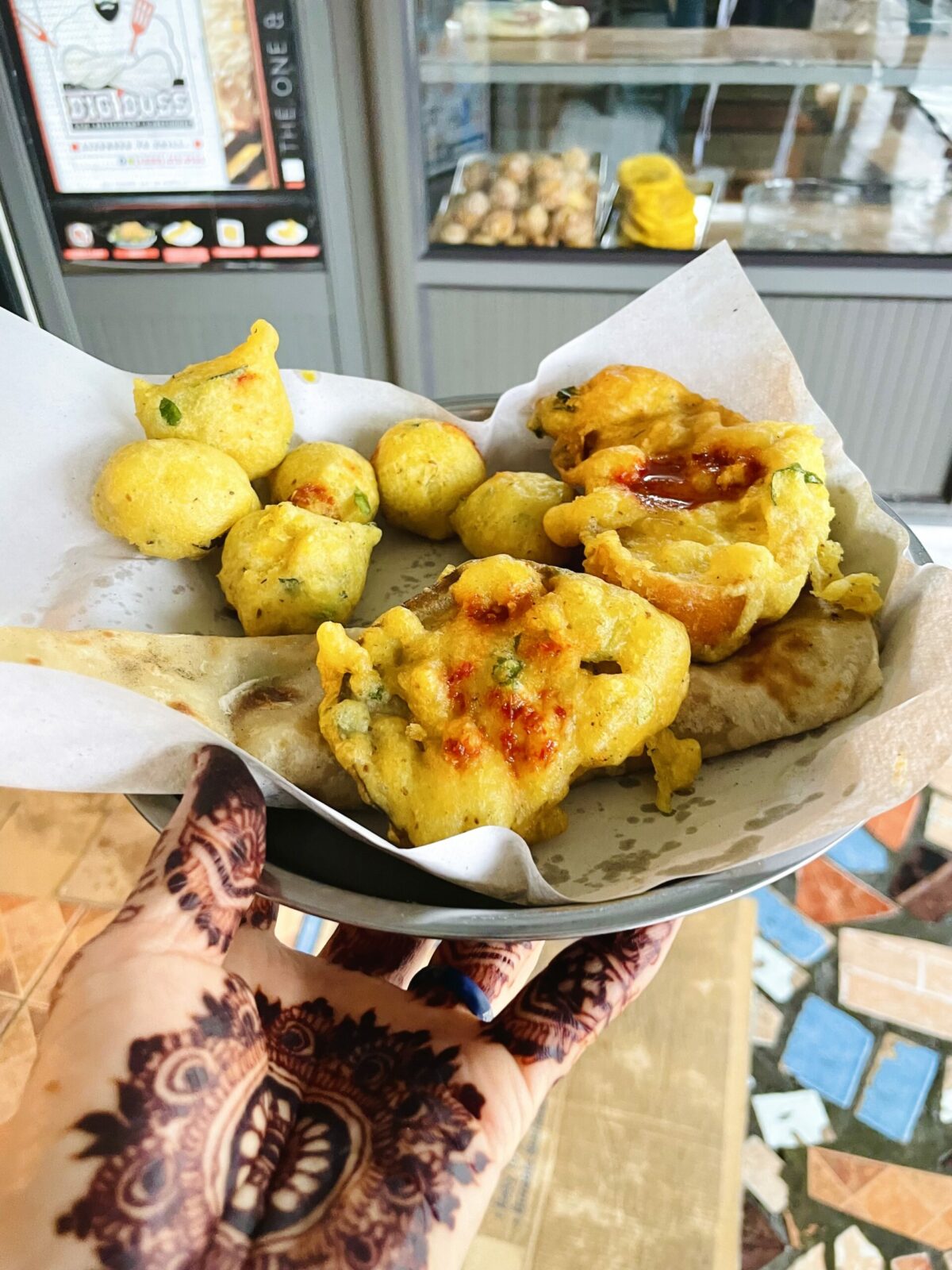
Picture: A plate of gato de l’huile and red chili sauce in Centre de Flacq.
Numbers 14-20 showcase the ones that are popular and that you should not skip on. As with the the boulettes, you can buy one of each and try them all!
There’s a popular snack establishment in Port Louis, close to the Muslim region of Plaine Verte, called Hotel Pakistan (it is not a hotel). They sell these gato de l’huile in the wee hours along with hot tea
14. Gato pima (chili and dal ball bites)
Gato pima (pronounced pee-mah), sometimes called chili bites or chili cakes, is made with yellow split pea mixed with dried red chilis or fresh green chili peppers, green onion and cumin powder.
Similar to falafel, gato pima are, without a doubt, the front-runner when it comes to gato de l’huile. In fact, chili bites are so popular that there are many street vendors selling these exclusively.
They are usually sold in sets of 10. You might think that these are sharable, and technically they are, but they are so scrumptious that you will probably want to keep all of them to yourself!
Some people make a meal about of them by spreading some butter in bread and stuffing it with crushed gato pima.
15. Gato arouille (taro)
Gato arouille (taro fritters) are deep-fried balls of shredded taro and sometimes ginger. Crispy on the outside and soft on the inside, they are served with a generous amount of red chili sauce. I could eat so many of these!
16. Samosa
Samosa is another popular Mauritian street food. If you are used to the Indian samosas with the thicker pastry dough, you might be pleasantly surprised to learn that ours are smaller, and wrapped in a very thin pastry sheet which results in a morsel that is deliciously crispy and bursting with potato goodness.
Mauritian samosas are stuffed with mashed yellow potatoes and peas along with some herbs and spices.
17. Du pain frire
Another popular and nostagic snack is du pain frire, or “fried bread”. Slices of stale bread are dipped in a chickpea batter that is perfectly seasoned with cilantro and spices, then deep-fried to perfection.
Like other gato de l’huile, du pain frire are served hot, with some tomato chutney, cilantro chutney and sometimes even coconut chutney. This snack might sound humble but it packs a punch in flavor.
18. Gato Pomme de terre frire, aubergine, patate (potatoes, eggplant and sweet potato/yam)
Pomme de terre (potatoes) frire, aubergine (eggplant) frire and patate (sweet potato) frire are made and served exactly the same way as du pain frire. Our sweet potato has a yellow/white flesh, not orange, with red/fushia skin.
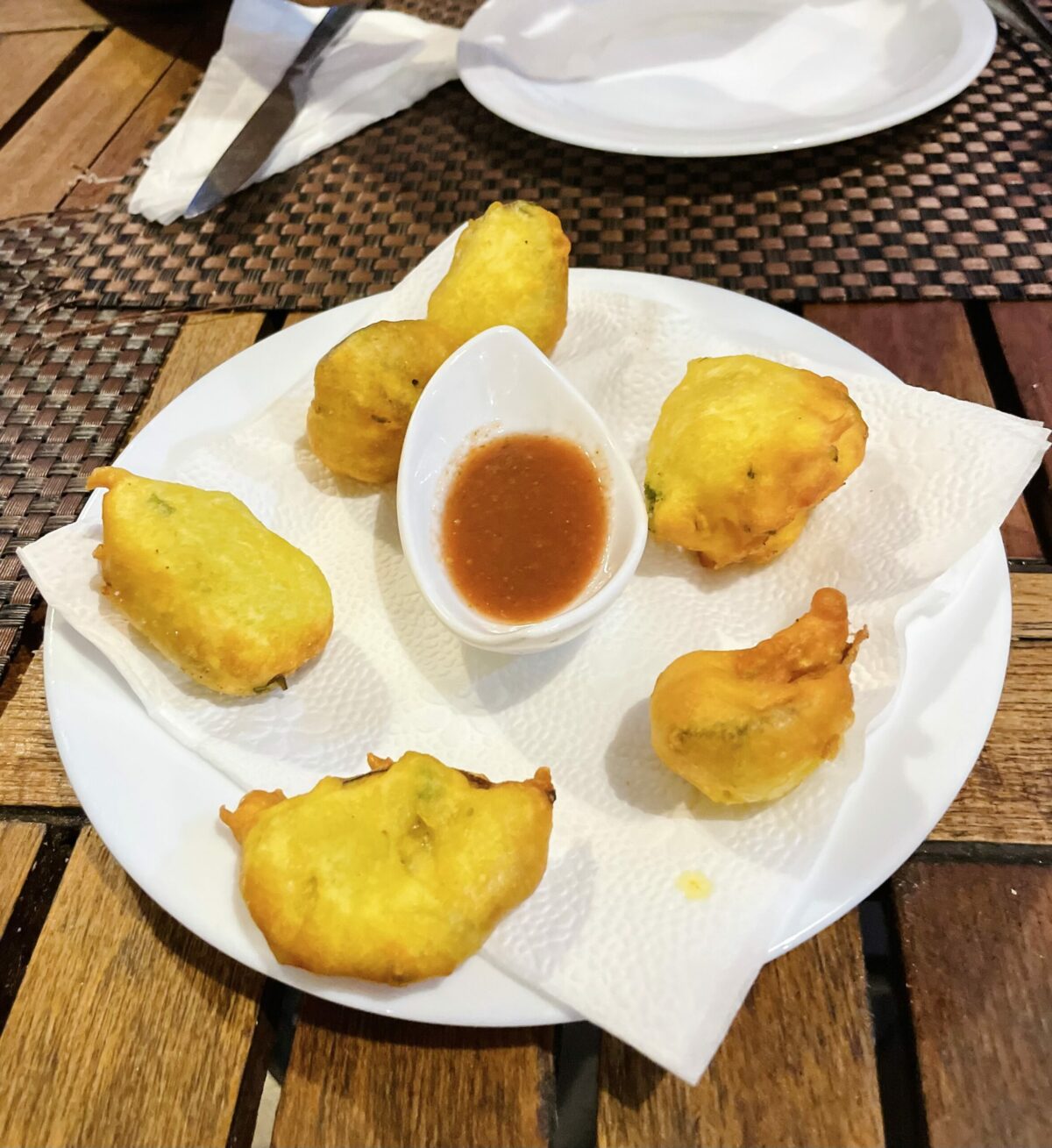
19. Gato fruit à pain (breadfruit fritters)
Gato fruit à pain (breadfruit fritters), are my ultimate favorite and they are not as easy to find as the others. They are prepared the same way as du pain frire and are quite filling due to the starchy nature of breadfruit.
Breadfruit, while technically a fruit, is more often enjoyed as a starch akin to how you would use a potato or sweet potato. Its closest relative is the more commonly available jackfruit. It’s roughly the size of a small cantaloupe and is grown on tropical islands like Mauritius.
When I lived in Florida, I was able to find breadfruit in most Caribbean grocery stores. Unfortunately, in Southern California, it is not as common and when available, the quality is not always there. So evidently, I deeply miss breadfruit and would get gato fruit à pain at every opportunity.
20. Bajia (chickpea dough balls)
Round, soft and simply spiced, bajia are little chickpea dough balls deep-fried until puffed and slightly golden. They are quite filling so only grab a couple of them if you would like to try the other gato de l’huile as well.
They are enjoyed on their own or with tomato chutney and cilantro chutney.
21-23🥐SAVORY PASTRIES
I cannot mention Mauritian street foods without mentioning the numerous pastry shops across the island. Most of them are unassuming little shops but in the capital of Port Louis and some other busier towns, you would find pastry shops with larger selections.
My favorite savory pastry is feuilleté poisson (fish puff pastry). The feuilletés are crispy and flaky from the pastry sheets separated by a layer of butter.
21. 🥐Feuilleté poisson (usually tuna)
If you can only try one type of feuilleté and like fish, you should try our feuilleté poisson. Usually made with tuna, feuilleté poisson is savory and a touch sweet from the addition of onion in the filling.
I haven’t found anything quite like it overseas and I’m very fond of this baked good.
22.🥐Feuilleté boeuf (Beef) or poulet (chicken)
Feuilleté boeuf and feuilleté poulet are made using the same method but with minced beef and minced chicken respectively.
23.🥐Gato fromage (Cheese sticks)
So here is the word gato again and here it simply means baked savory treat. Flaky, buttery and slightly salty from the cheese, gato fromage are cheese sticks. Think of it as rectangular savory scones (if you are British), or breakfast biscuits (if you are American), with a salty bite rather than puff pastry.
They are not as common as they used to be. This is not necessarily a must-try although if you love cheese and flaky savory biscuits, they might knock your socks off.
24. Gram bouillie (Black chickpeas with curry leaves)
Gram bouillie are boiled black chickpeas tossed with cooked onion, curry leaves, dried red chilies and spices. These are another nostalgic street snack that is a bit harder to find these days, but oh-so tasty, with the perfect balance of flavor and texture.
Mauritian gram bouillie are usually made on the spot and sold with other boiled or dry roasted treats like dry-roasted peanut kernels, boiled peanuts in their shells and dry roasted dal.
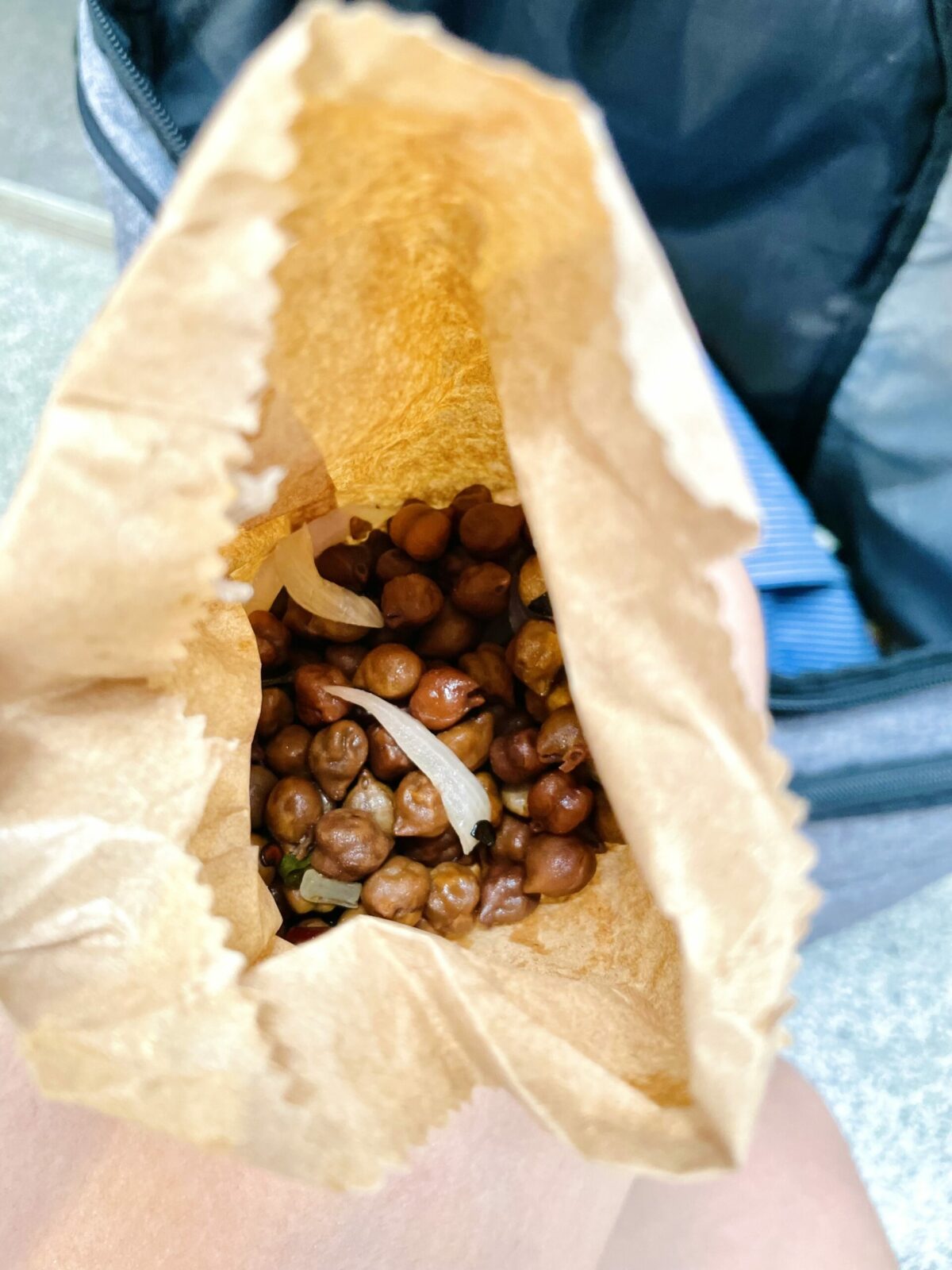
25. Pistache grillé (Dry roasted peanuts)
It’s hard to miss those peanut treats with their attention-grabbing fuschia-colered skin. Pistache grillé are dried peanuts kernels slow-roasted in a large iron pan with some sand.
The sand redistributes the heat so that the peanuts do not cook too quickly or burn. This dry-roasted imparts a slightly smoky flavor to these tasty nibbles.
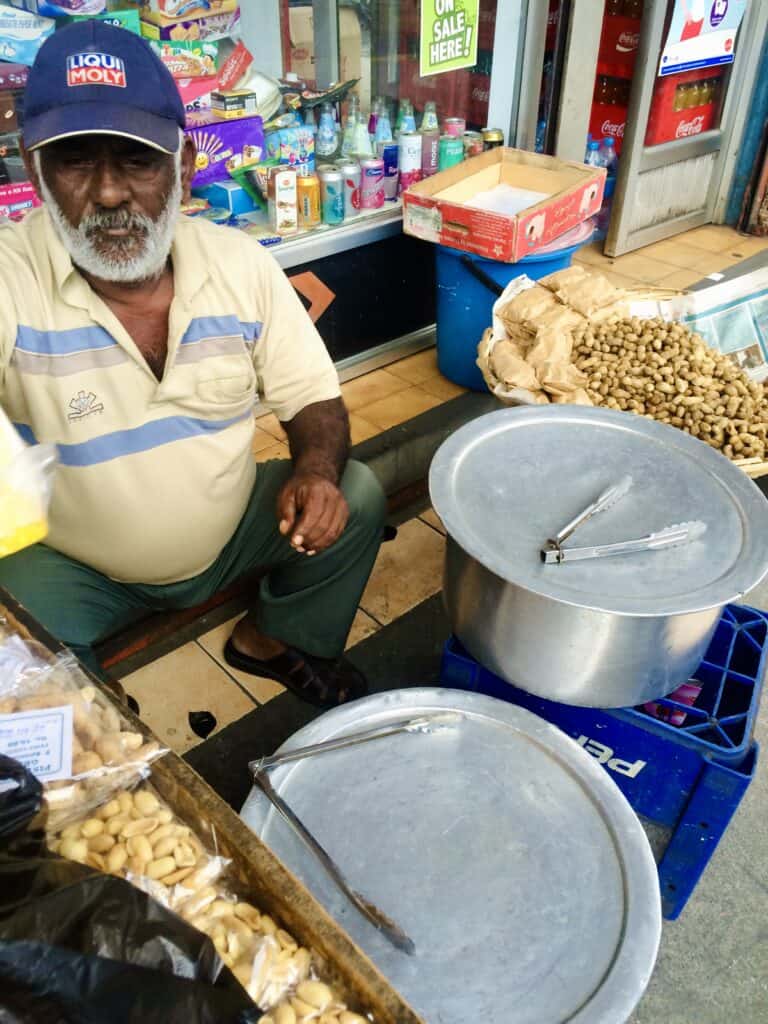
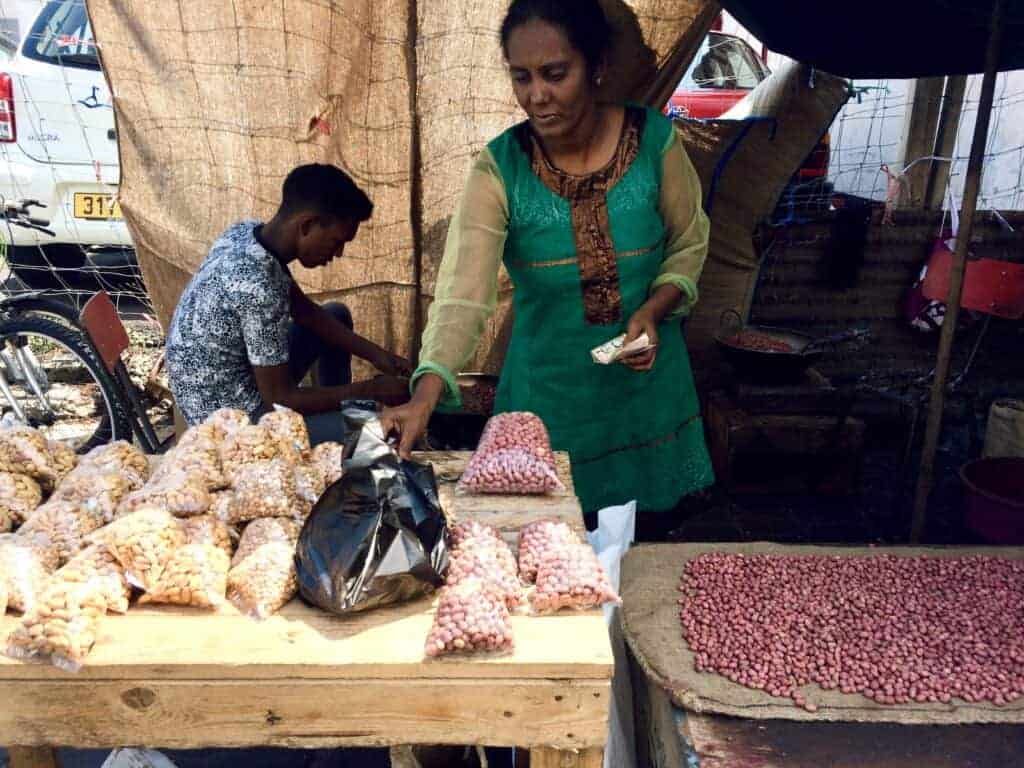
26. Crêpe salé avec satini (Savory crepes with chutneys)
Crêpe salé avec satini, are a typical Mauritian dish with French and Indian origins. Made with a flour, water, green onion and salt batter, crêpe salé tastes incredibly fresh with its accompaniments of tomato chutney and cilantro chutney.
27. Merveille avec satini
I would like to wrap up this Mauritian street foods list with a traditional Mauritian snack so modest that it only uses flour, water and salt. Evocative of a by-gone era when people were really poor in Mauritius, merveille would be the snack of choice.
It fills the belly and doesn’t break the bank. Merveille literally translates to marvel and after doing some research on it, I’m still not quite sure where the name comes from. Please leave me a comment below if you do.
Slightly reminescent of the Indian papadum in its shape and texture, merveille is a Mauritian creation that will take you down memory lane like no other street food would. Deep fried until golden, these crispy street fares are served with tomato chutney and sometimes cilantro chutney.
Although common back in the days, the Mauritian merveille was leaving the street food scene to the point where you would only be able to find them in villages, but now they are making a comeback and I hope they are here to stay.
Conclusion: Food for thought
There you have it guys. When you visit Mauritius, take the time to savor the street foods along the way. And while you are at it, take a minute to get to know the street vendors selling them.
Each one of them has a story and oftentimes it’s a story of hardship, perseverance and the love of food.
Mauritius is a country of immigrants who have made this beautiful island their home, some by choice but most by force. Like other islands, there’s a history of oppression, slavery and a nation that finally overcame and won their independence.
Our ancestors brought with them their recipes. In an unknown land that didn’t have the necessary original ingredients, they had to make do with what our volcanic island had to offer. The beautiful result of all that is what we call Mauritian Street Food.
If you found this article helpful, please share it. If you have any questions, please leave me a comment below.
Welcome to our beautiful Mauritius Island!
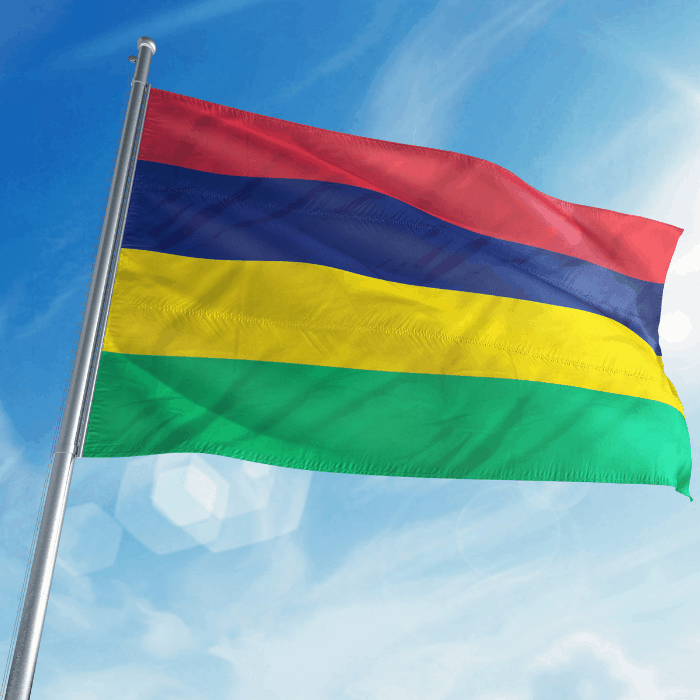
Cook Mauritian Food
What would you like to do next? I invite you to have a go at cooking your own Mauritian food. I share Chef-tested and Authentic Mauritian Recipes.
I recommend trying Mauritian Fish Vindaye, a typical dish that you have to try if you find it on a restaurant menu on your visit. Although it’s not quite a street food, you can definitely find it in some areas of the country.
The Mazavaroo Chili Paste is a must as it accompanies almost all Mauritian food.
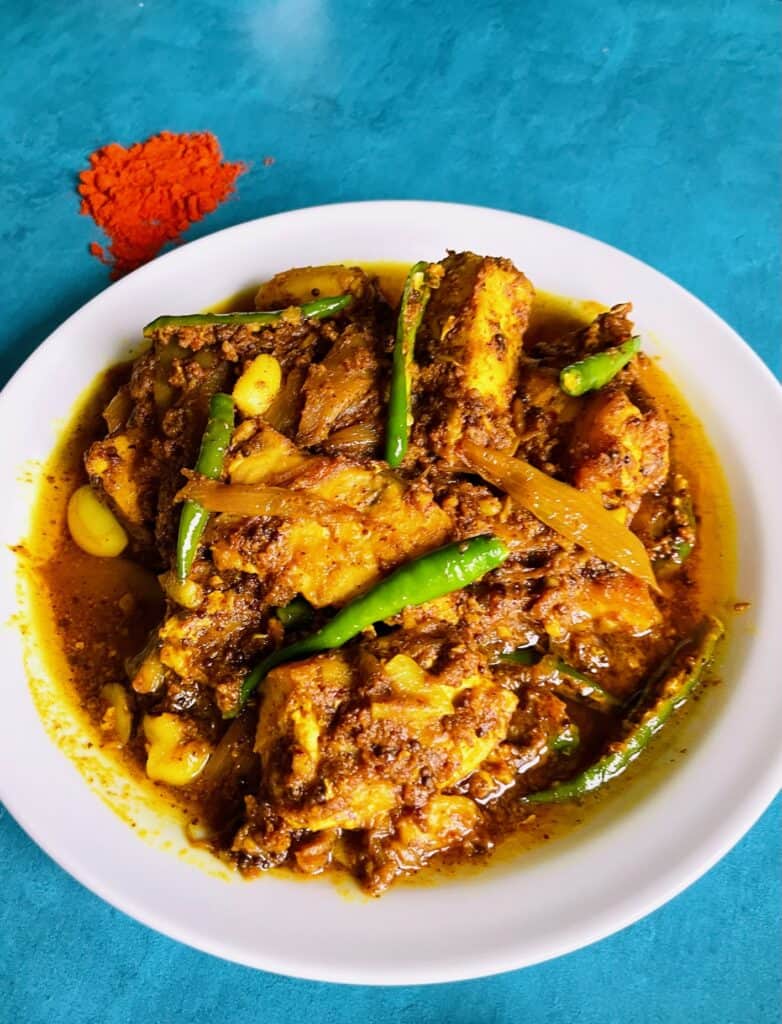
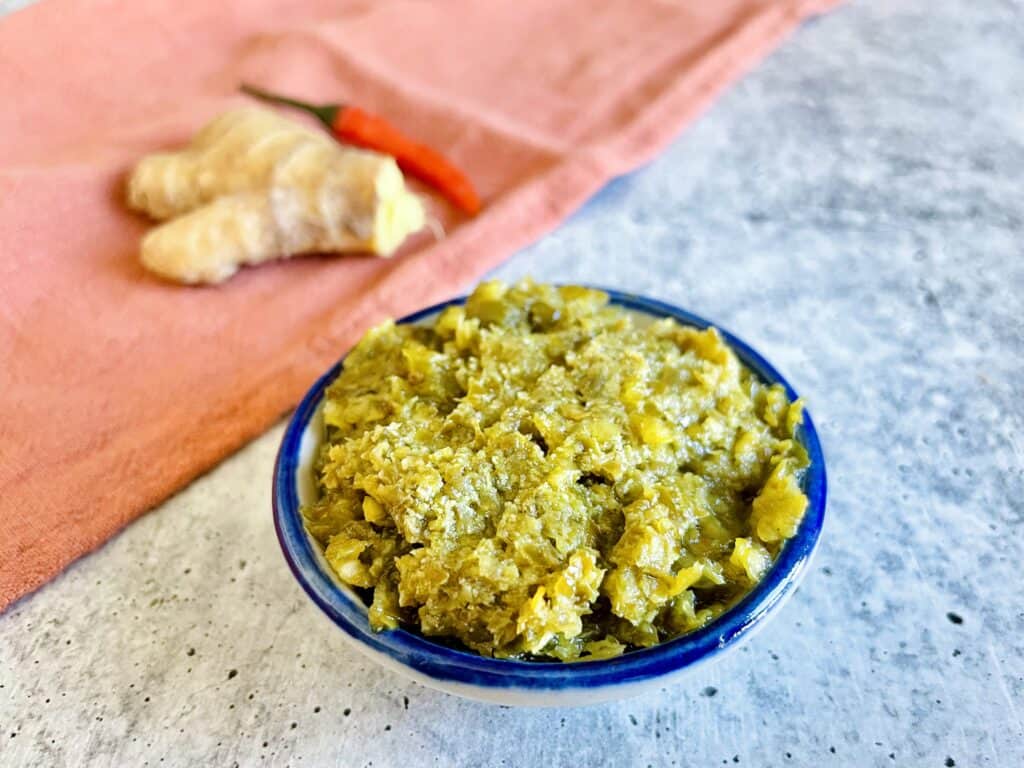
From left to right: Mauritian fish vindaye and Mazavaroo chili paste
Sharing is Caring
If you like enjoyed this list, please share it with your family and friends. I am also on Facebook, please follow my recipe updates there.
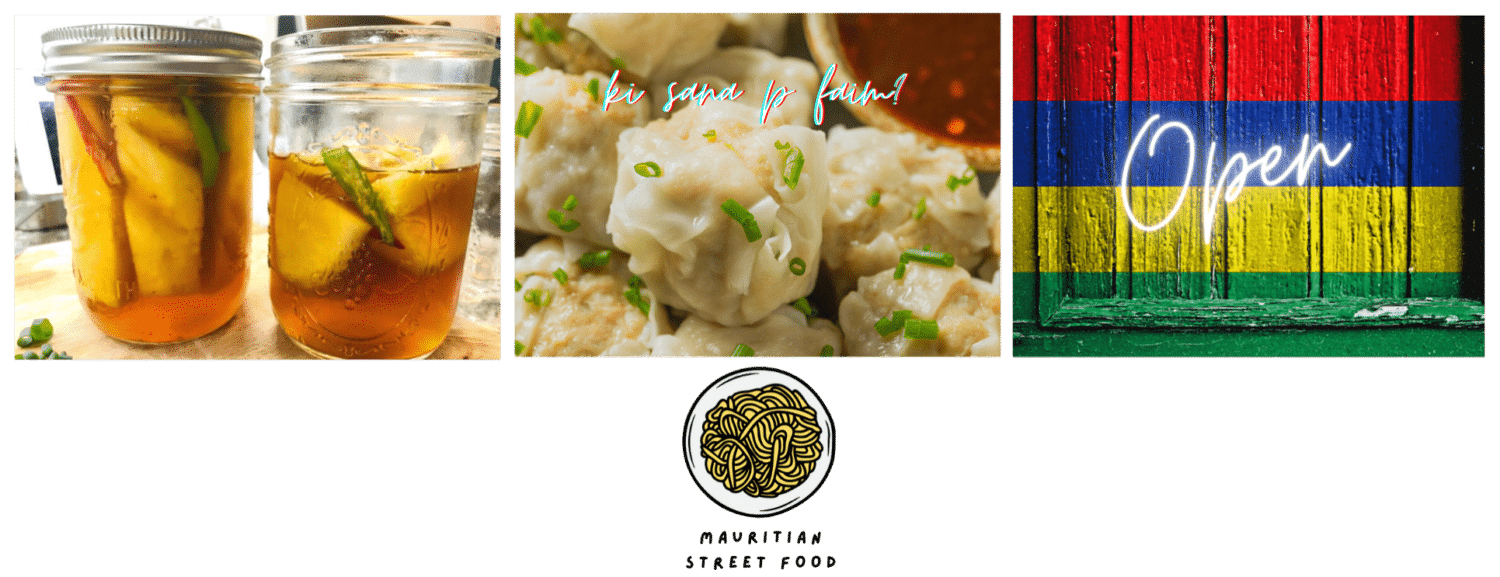

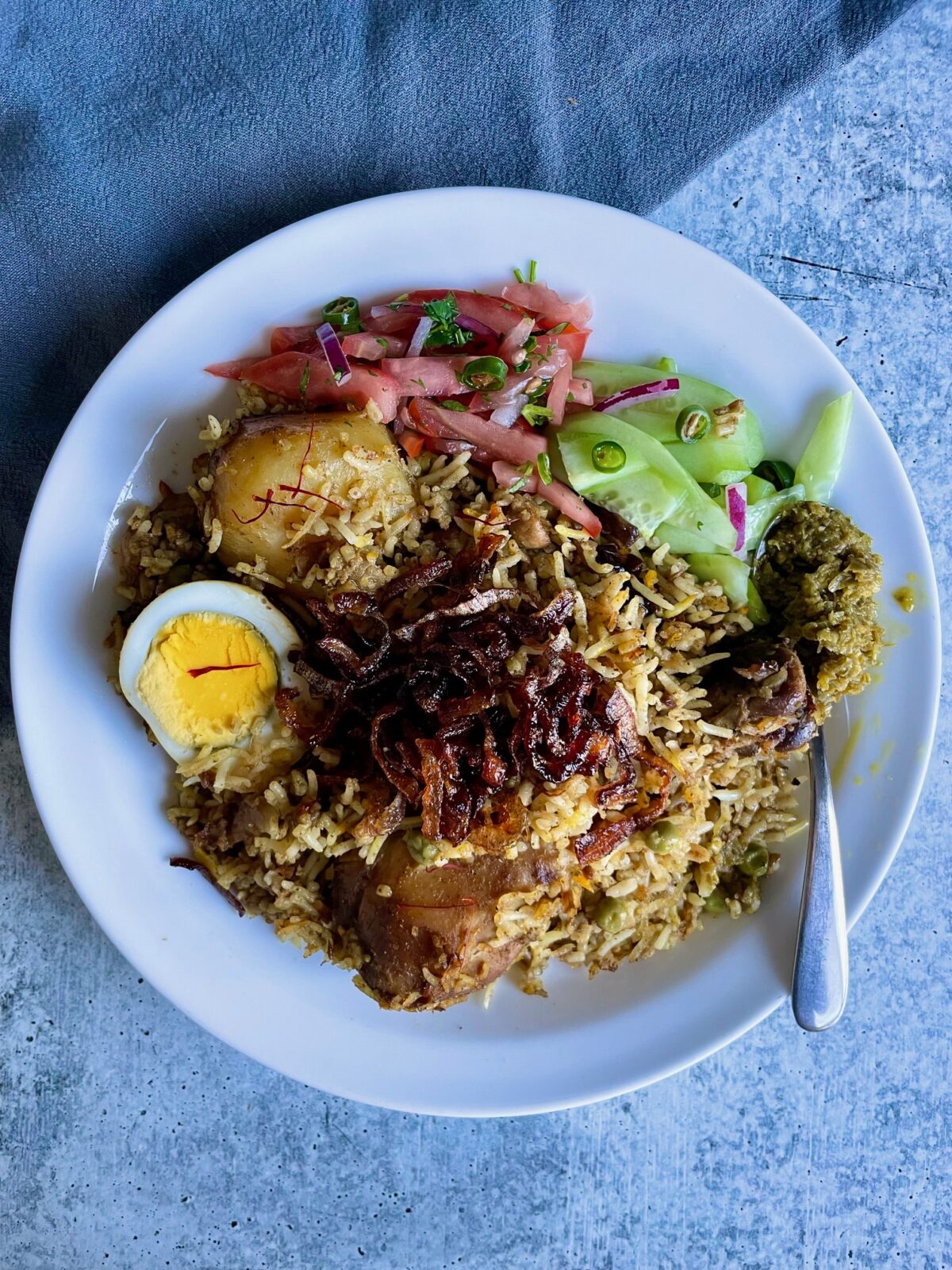
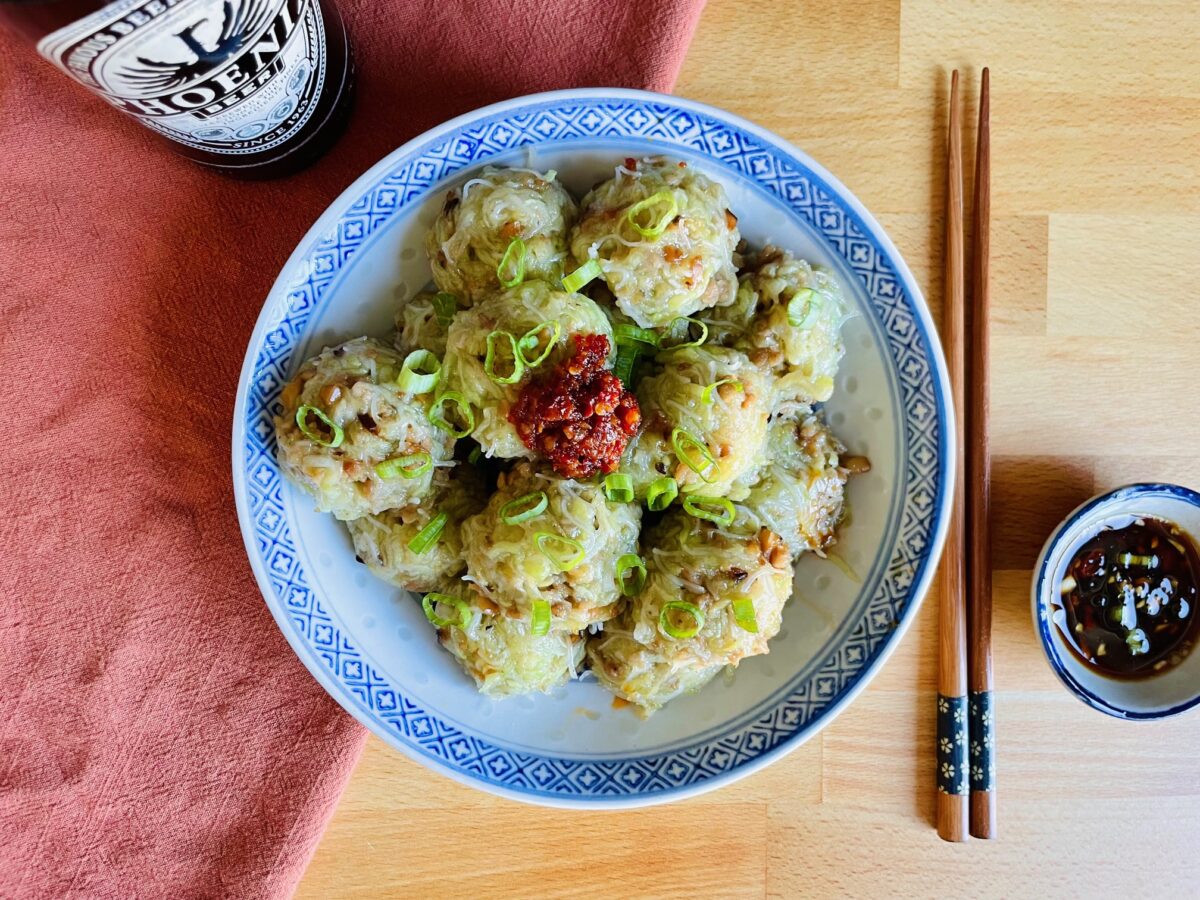
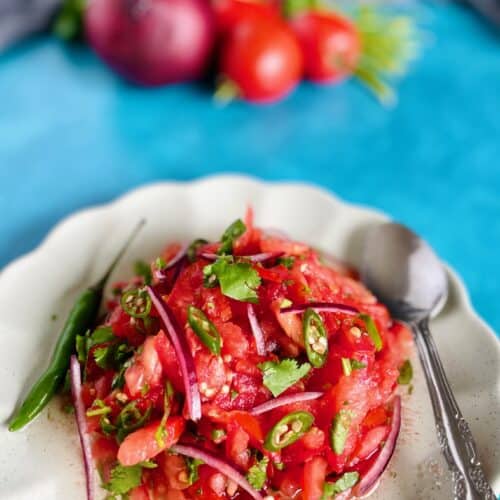
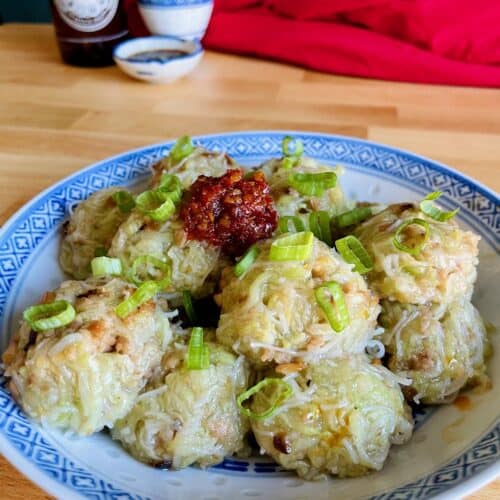

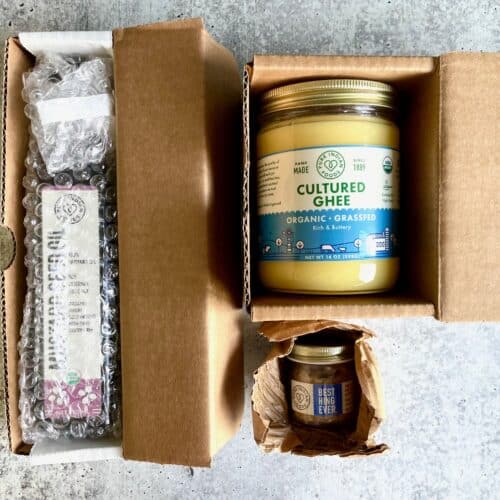
Hi
Your savoury description of the street foods bring ‘l’eau a la bouche’,even though i’m from Mauritius itself!
So tomorrow itself i’ll roam along Port louis to enjoy some ‘merveille’,dipain frire,mine frit…
Thks
Raja, I’m so pleased to hear that. Please stay in touch, more to come! Happy Holidays :).
Hi Eliette. Reading this while sitting on Koh Kradan in Thailand and already planning a trip Closer to home (Cape Town) in a few months. Stumbled across your site and blown away by the incredible detail of some amazing street foods of the cultural melting pot that is Mauritius! Never been and am now booked and will use your site as point of reference
Thank you so much 🙏
Jonathan, I’m so delighted to hear that the Mauritian street food list was helpful and that you’ll be visiting my beautiful island. Please revert and let me know how you enjoyed it! Warmly, Eliette.